Here’s our guide to the top spots to see spectacular foliage during autumn in Kyoto. Stroll the tranquil grounds of magnificent temples, trek trails, wander off beaten paths, and enjoy traditional sweets.

Autumn is undoubtedly one of the most spectacular, ephemeral, and exciting times of the year in Japan: it is a season of vibrant colors and breathtaking scenery. If you search online, Kyoto will likely pop up as the go-to destination to see 紅葉 (kōyō – autumn leaves or foliage) in Japan. I had the pleasure of exploring the historic temples and shrines buried among the autumnal tapestry of crimson reds and golden yellows for one week.

Throughout this four-part series, I will share insider tips on the best time to visit and highlight the top spots for enjoying crimson red maple leaves (紅葉) in Kyoto, along with a bonus episode in Osaka.
- Autumn in Kyoto Guide
- The Best Things to Do in Arashiyama Autumn
- Day Trip To Uji Japan: A Cultural Experience
- Osaka Autumn Travel Guide
Table of Contents
- When Is Autumn Leaf Season in Kyoto?
- Tips to Enjoy Autumn Leaves in Kyoto
- Tofuku-Ji Temple
- Daigo Ji Temple
- Kiyomizu-Dera Temple
- Nanzen-Ji Temple
- Kodai-ji Temple
- Koknai Komyou-ji Temple
- Eishoin Temple
- Shinsou Gokuraku-Ji Temple
- Eikando Temple
- Arashiyama
- Ninna-Ji
- Ryoan-Ji
- Enkouji
- Sanzen-in
- Kifune Shrine
- Enjoy Autumn in Kyoto – Koyo
When Is Autumn Leaf Season in Kyoto?
As a general rule of thumb, Kyoto’s foliage typically begins around mid-November and ends in early December. However, this timing varies from year to year, influenced further by Kyoto’s unpredictable weather conditions. During my travels from the 18th to the 25th of November, temperatures fluctuated between 0°C (32°F) on some nights and 20°C (68°F) on others. This temperature disparity had an impact on this year’s foliage, with many news outlets reporting less vivid colors than in previous years and a slightly delayed peak season.
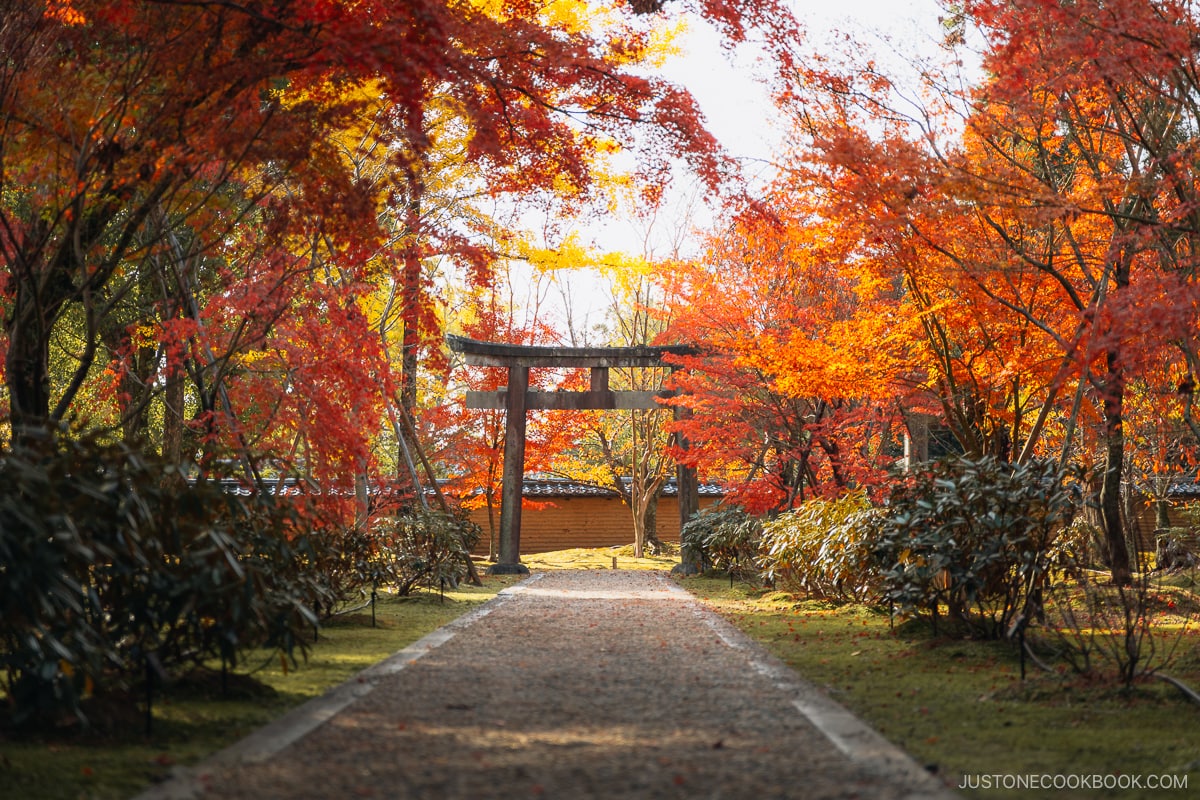
It’s crucial to note that Kyoto is a large city with countless spots to enjoy foliage. While one place may not exhibit any color change, another area may be in its peak season.
For that reason, I recommend checking autumn color reports online and Instagram posts to plan your visit accordingly. If you plan to book months in advance, I would suggest aiming for late November to early December.
Tips to Enjoy Autumn Leaves in Kyoto
Avoiding the Crowds
One thing you will immediately notice is that there are LOTS of people. In popular areas such as Kyoto’s famous geisha district, Gion, you’ll encounter shoulder-to-shoulder crowds, which can be overwhelming and detract from the excitement of the autumn leaves.
The first way to avoid the crowds is to arrive early. Many temples and shrines open between 8 am and 9 am, so I recommend visiting as soon as they open. You’ll be able to roam the grounds freely with very few people compared to the peak hours in the afternoon. Note that popular areas such as Kinkaku-ji will be busy no matter the time.
Logistics
To get from one side of Kyoto to the other, you will need to take multiple buses and trains. Combined with the crowds, it can easily become tiresome. To maximize your time in Kyoto and fully take in the autumn colors, planning is crucial.
Before arriving in Kyoto, be sure to research spots that are within close proximity to each other. Split your days into different areas of the city, such as north, east, south, and west. Not only will you minimize travel stress, but you will also maximize your time gazing at the autumn leaves. Learn more about how to get around Kyoto here.
Explore
While some of the more well-known areas, such as Kiyomizu-Dera Temple, are must-visits, Kyoto is filled with countless smaller parks, shrines, and temples that are often left unexplored and are just as picturesque. During my trip, I frequently discovered tucked-away spots while walking between areas, which had little to no people but showcased some of the most impressive autumn scenery. Don’t be afraid to venture away from the popular spots and explore the whole city!
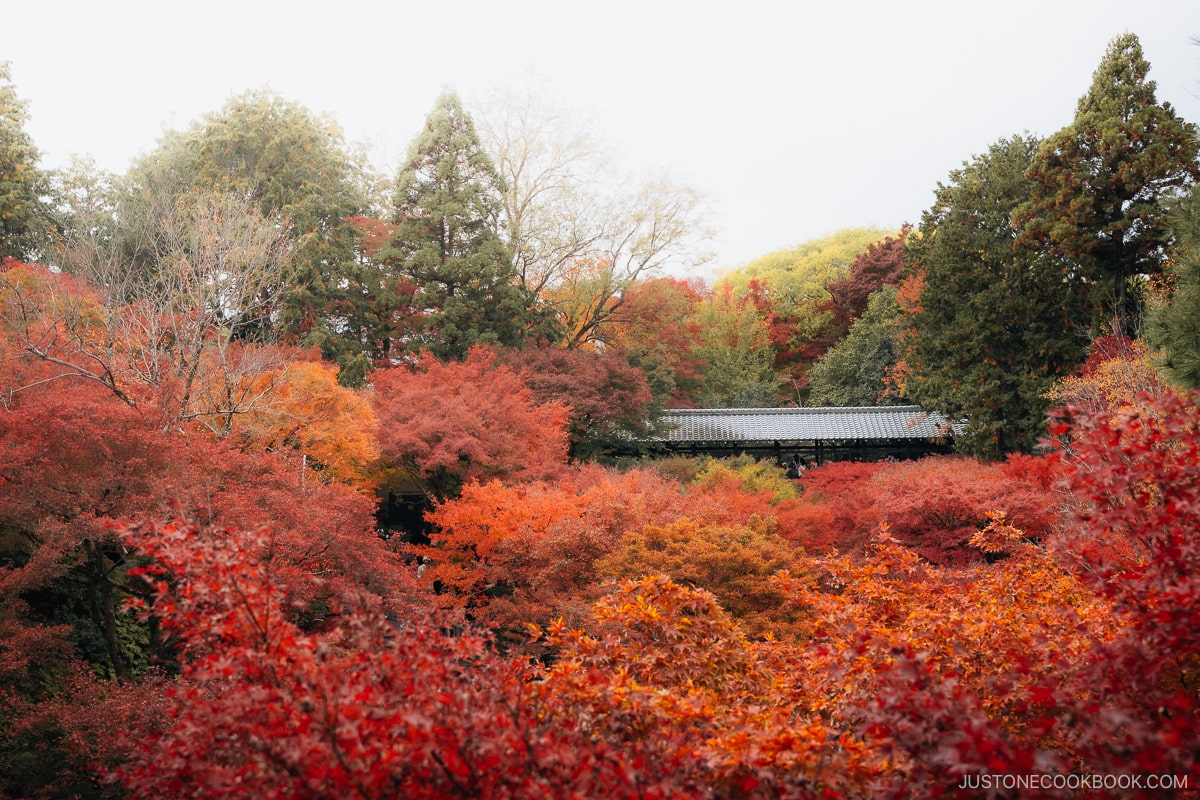

Daigo Ji Temple

Kiyomizu-Dera Temple

Nanzen-Ji Temple

Kodai-ji Temple

Koknai Komyou-ji Temple

Eishoin Temple

Shinsou Gokuraku-Ji Temple
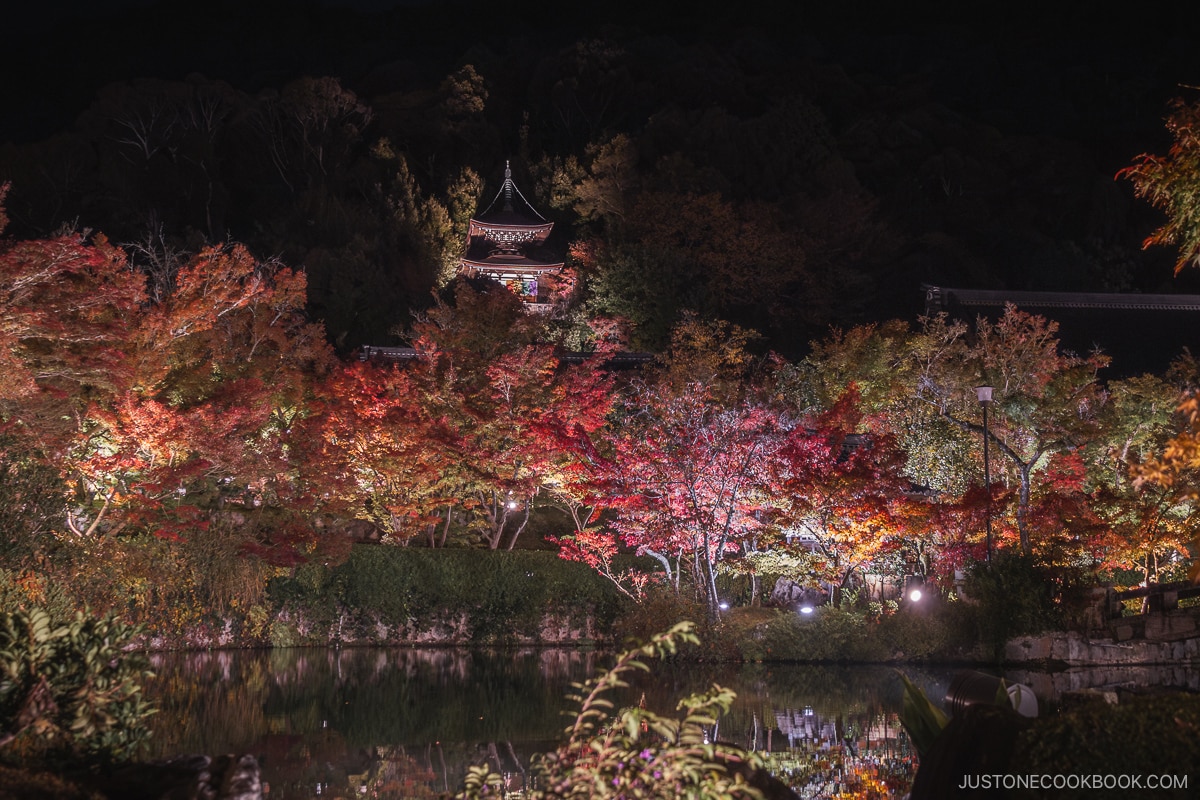
Eikando Temple


Ninna-Ji


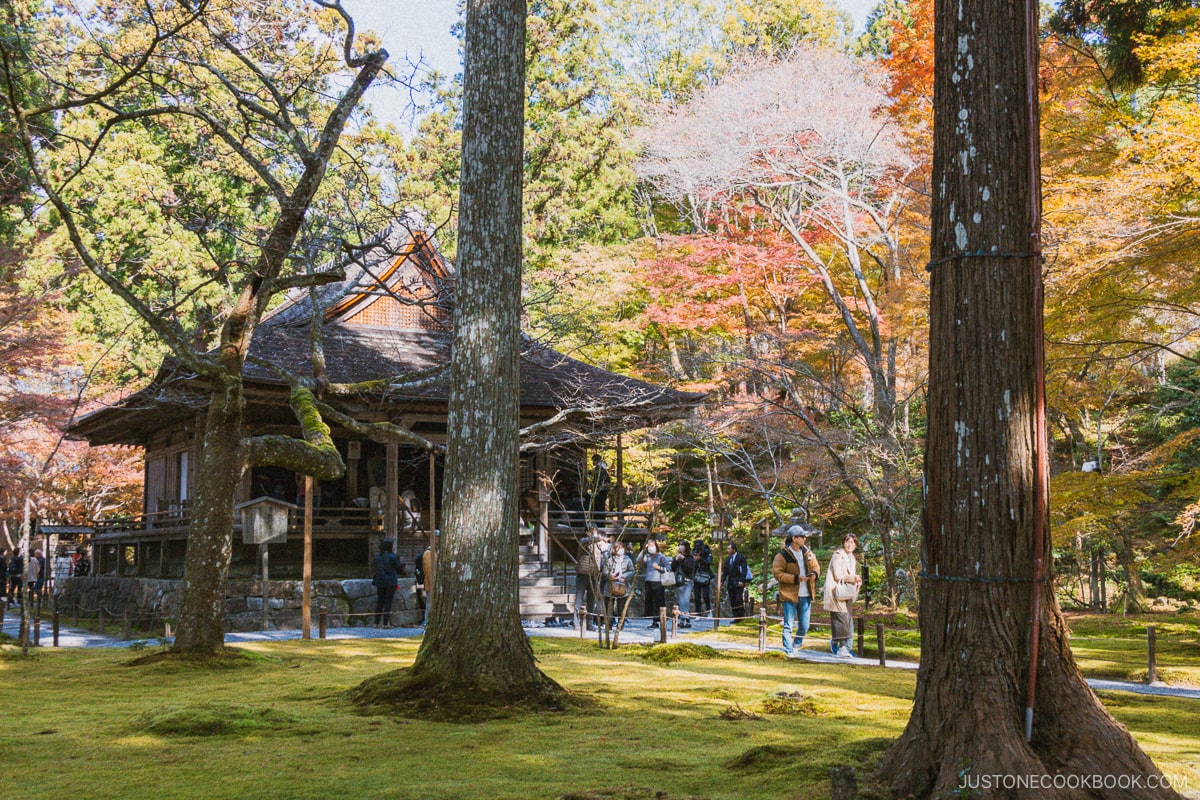

Tofuku-Ji Temple
Located on the southeast side of Kyoto is Tofuku-Ji, a Zen temple famously known for its autumn colors.
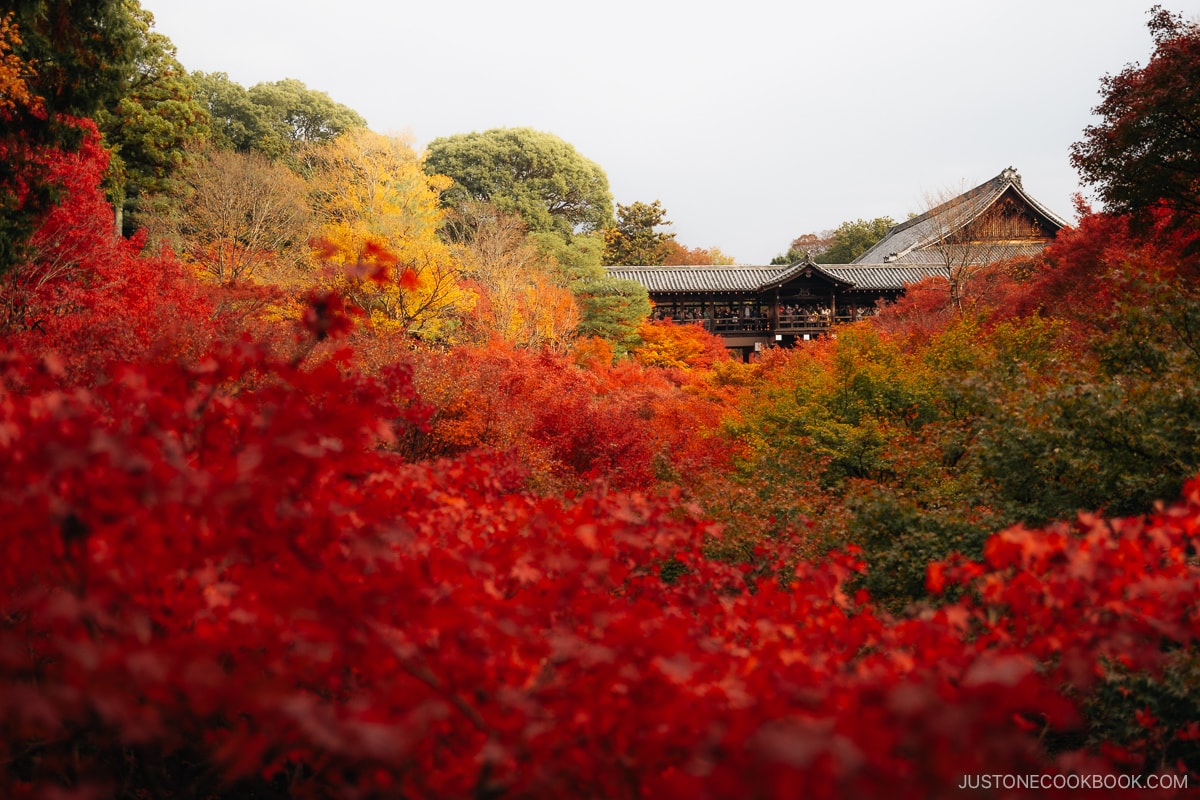
Construction of the temple began in 1236 under the instructions of Kujo Michiie of the Fujiwara Clan and was completed in 1255. The goal was to create a temple similar to the two great temples of Nara, Todaiji, and Kofukuji, with Tofuku-Ji being a combination of the two.

The temple complex comprises multiple structures, such as the impressive Sammon Gate and the serene Honbo Garden. You’ll also find some small cafes and a flea market selling local goods.


The main attractions during autumn are the Tsutenkyo Bridge and the myriad of gardens beyond. To enter, there is an admission fee of 600 yen for adults and 300 yen for children.
Upon entering, you’re greeted by dozens of maple trees that blanket you in vermilion red.


The garden meanders down into a small valley, where you can see the autumn leaves in all their glory as far as the eye can see.



The path will lead you to Kaisando, a small temple, where you can sit and soak in the scenery.


Then on to Tsutenkyo Bridge, which will lead you to a remarkable view over all the autumn leaves. From here, the scene resembles clouds of reds, oranges, and yellows.
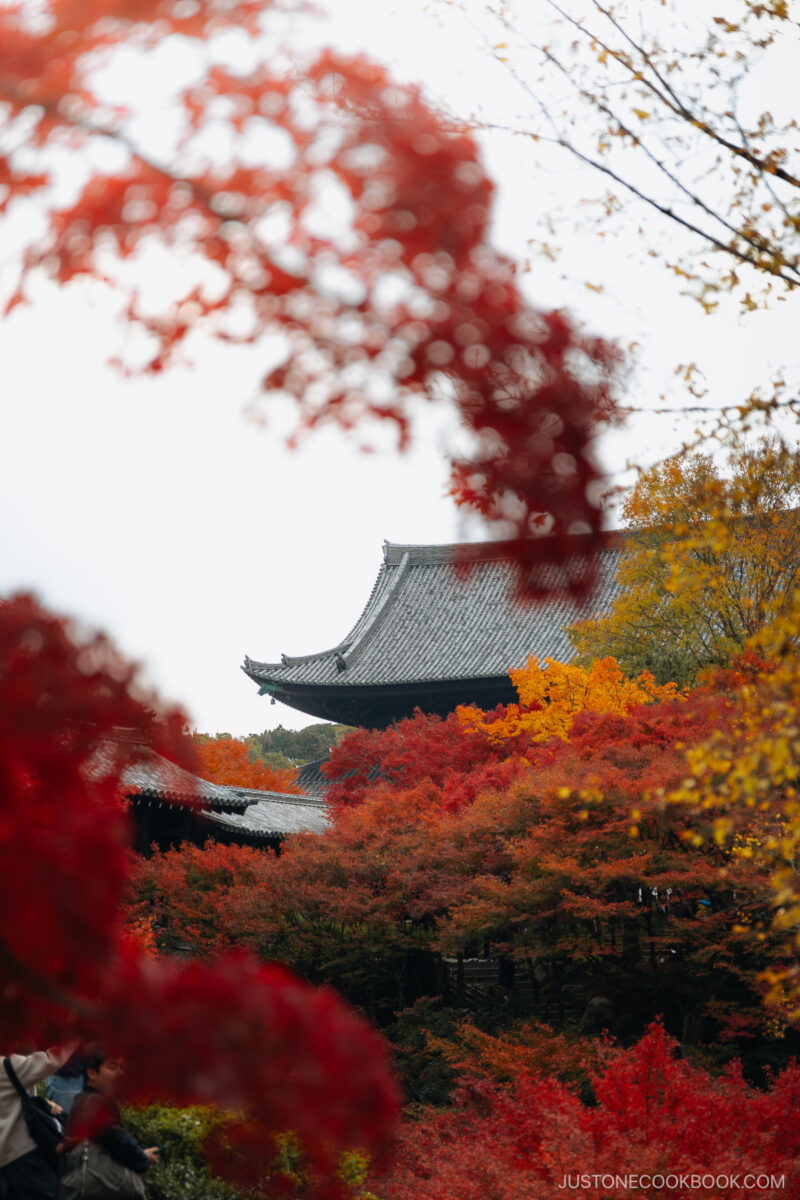
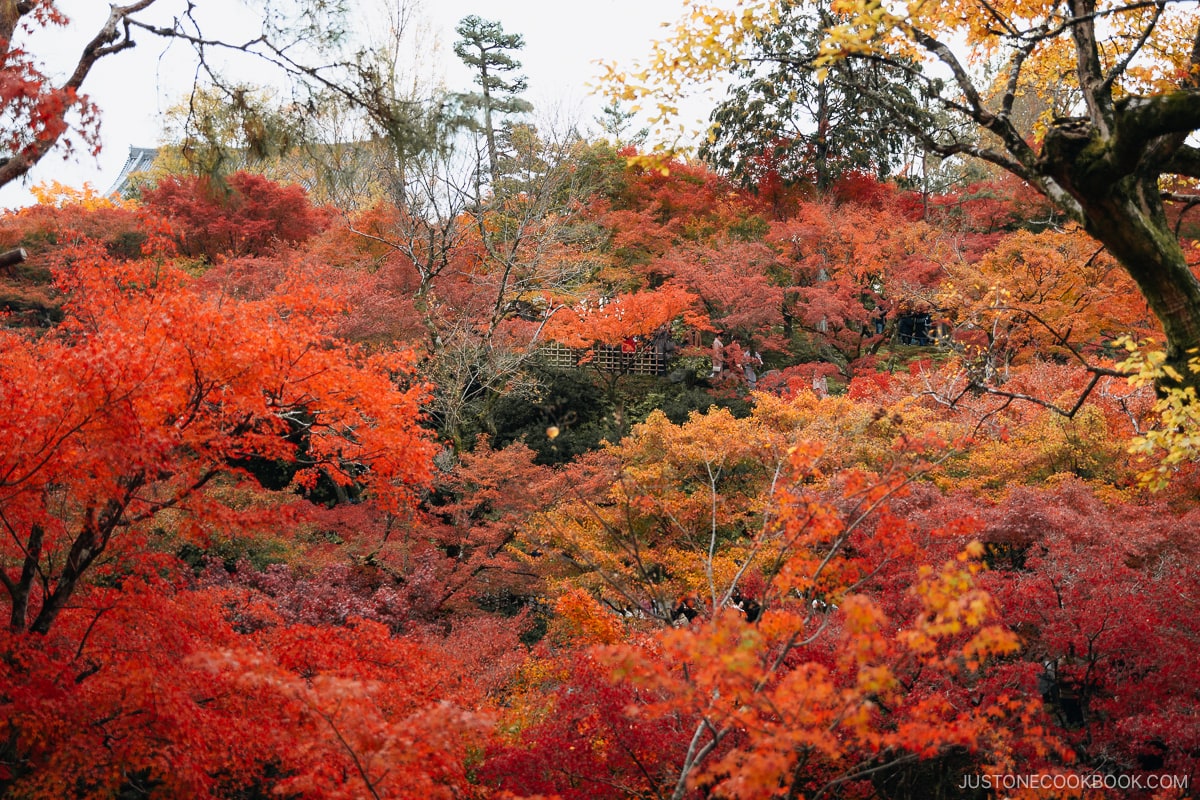
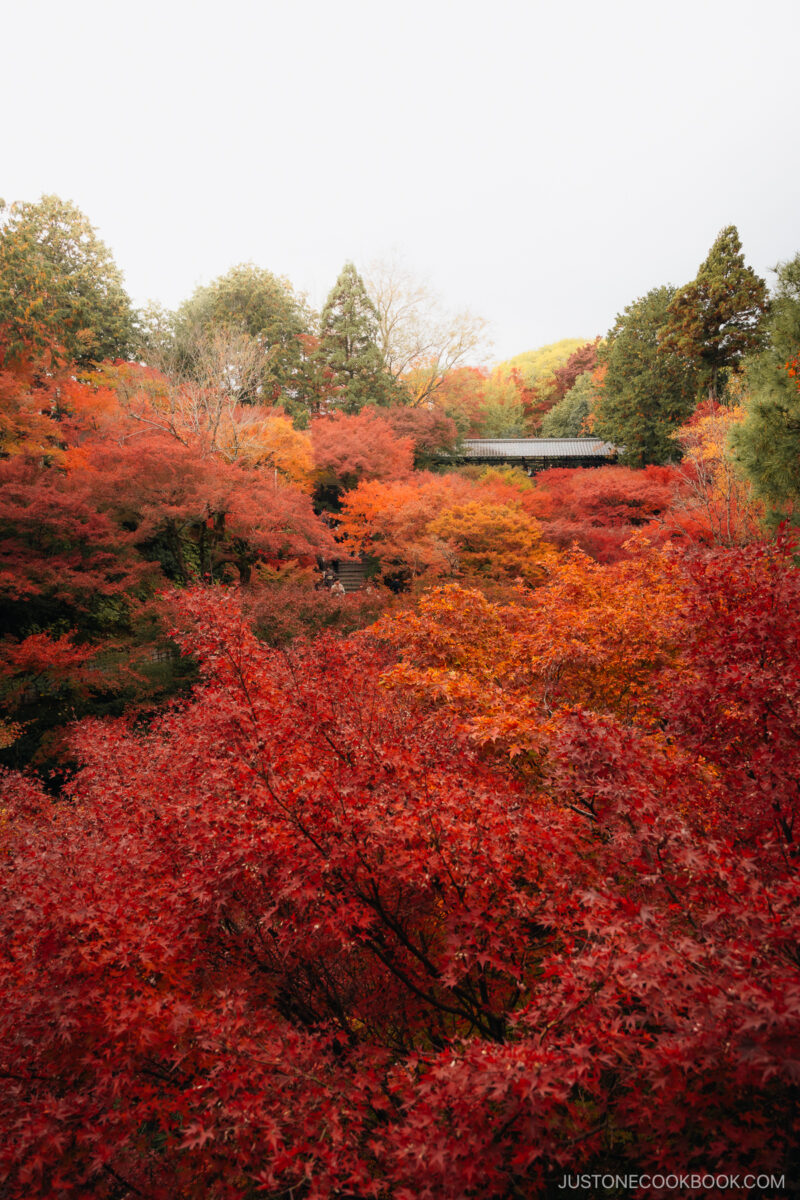

On the other side, you can see the Tofuku-ji Gaunkyo Bridge, which passes just outside the temple grounds.
Tofuku-Ji was one of my favorite spots of the whole trip because I had never seen that amount of momiji (maple leaves) atop such beautiful architecture and setting.

Daigo Ji Temple
Located a little further east of Tofuku-ji is Daigo-Ji, founded by Shōbō Rigen Daishi, the disciple of Japan’s most famous monk, Kūkai. Legend has it that the surrounding spring water was as sweet as nectar, earning the temple the name Daigo Ji, meaning “exquisite taste.”

The temple was officially built in 874, boasting a rich history of 1,150 years, and is home to more than 150,000 preserved cultural assets, including a record of 75,537 National Treasures. In 1994, Daigo Ji was added to the list of UNESCO World Heritage Sites.

The main temple grounds are located at the foot of Daigo Mountain, with various hiking trails leading up the mountain to several more temples.
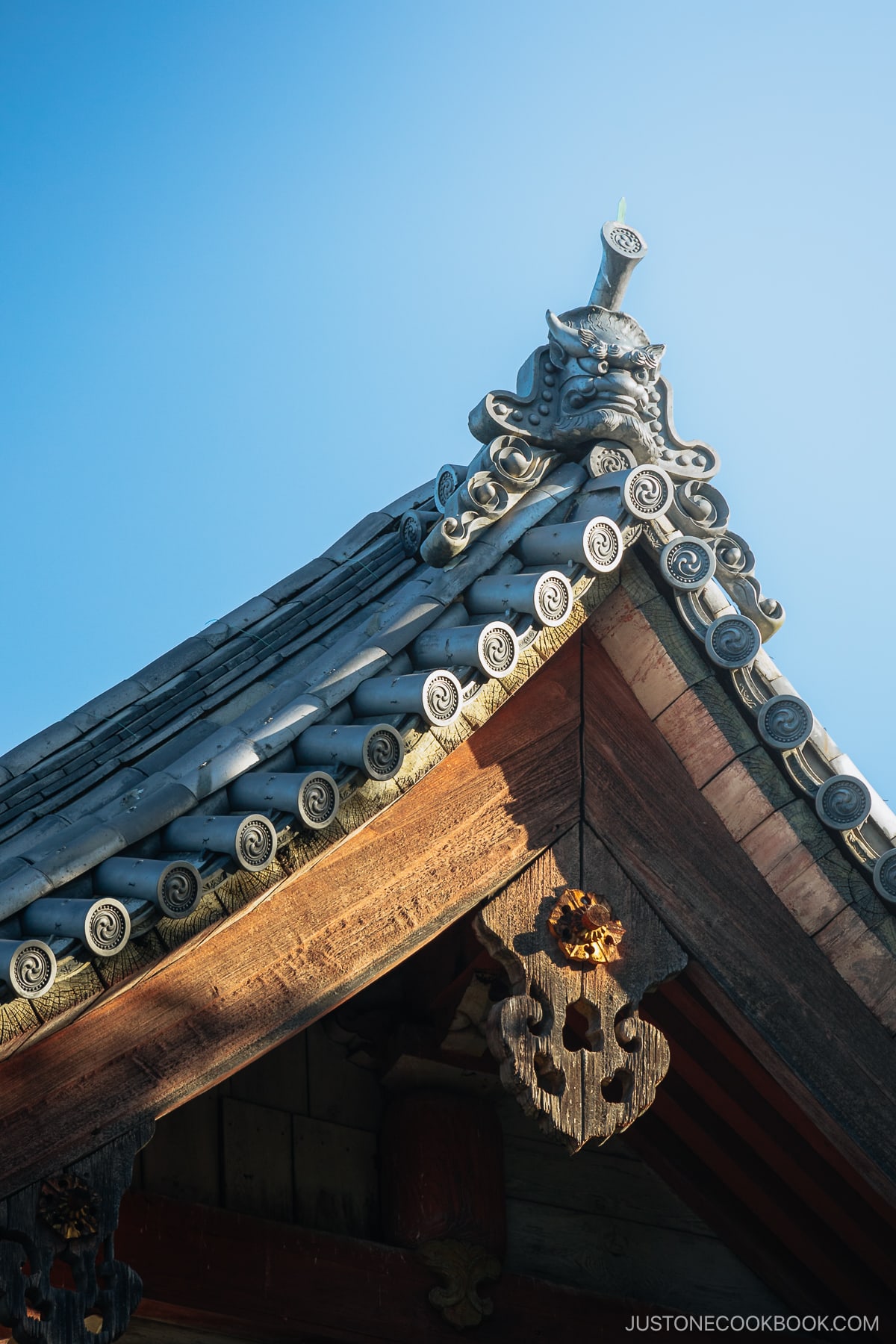
There’s a 500 yen admission fee to enter the temple grounds, where, as soon as you walk in, you will encounter Goju-no-to, a five-story pagoda constructed in 951. Known as the oldest structure in Kyoto, it has withstood numerous fires and wars throughout its history.

The path will then guide you to Sanboin, the former residence of the head priest, originally constructed in 1115.


The temple and beautiful garden were reconstructed for the great feudal lord Toyotomi Hideyoshi’s (1537-1598) cherry blossom viewing party in 1598.

You can sit, relax, and enjoy the stunning scenery as the autumn foliage reflects and glistens in the pond below.


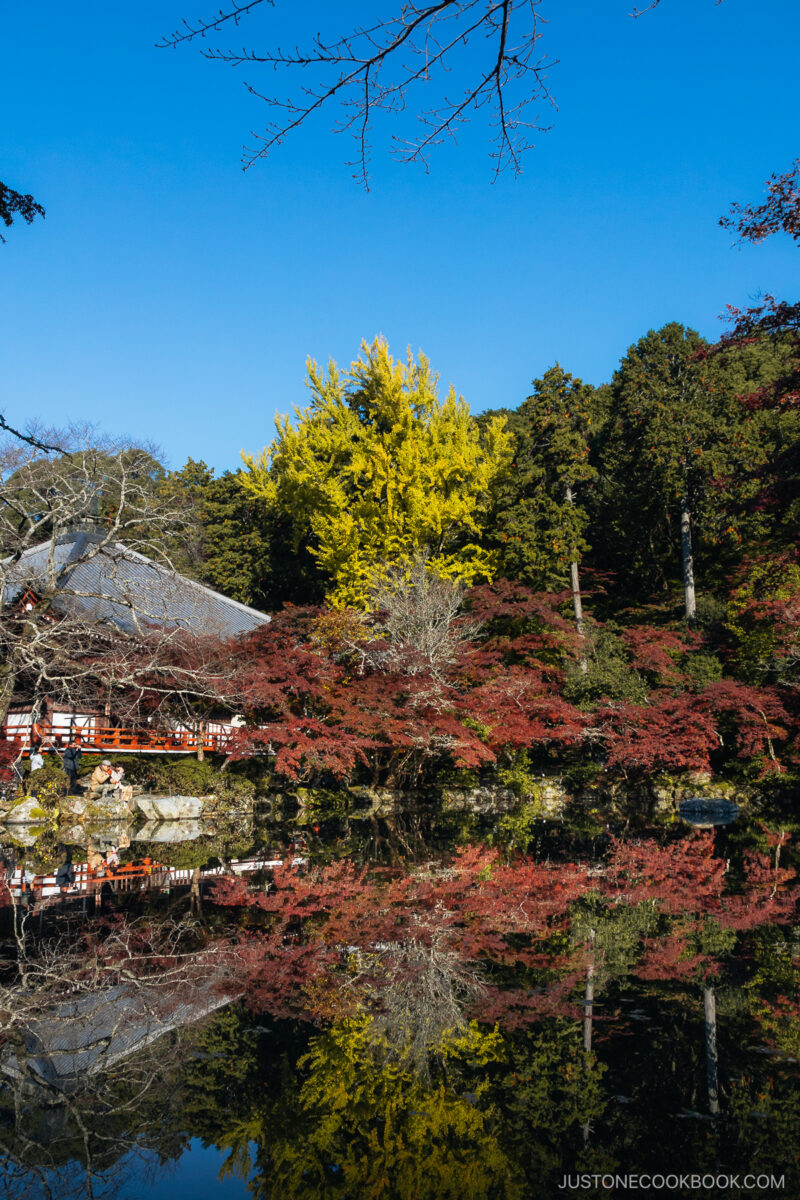
The view was one of the most picturesque during my trip, so I decided to come back in the evening to join the special autumn light-up.


Kiyomizu-Dera Temple
No trip to Kyoto is complete without a visit to Kiyomizu-Dera Temple. Anticipating the crowds, I decided to make a short visit so I could share with you a glimpse of its atmosphere during the autumn season. Leading up to the temple are the narrow streets of Gion, lined with various shops, cafes, and restaurants. These streets are packed shoulder-to-shoulder with people, so if you don’t enjoy crowds, this may not be the ideal destination for you.

Inside the temple grounds, you’ll be able to see the stunning red momiji with the backdrop of the city and mountains.

During the evening there is also a special light-up show where you can enjoy the autumn leaves under the night sky.
Kiyomizu-Dera is undoubtedly beautiful in autumn and is worth a visit if you have never been before. Just be mindful of the large crowds.
You can read more about the temple itself in our Kyoto Travel Guide here.
Nanzen-Ji Temple
Next on the list is the Higashiyama area, famous for housing some of the most renowned spots in Kyoto, such as Ginkaku-Ji, The Philosopher’s Path, and Nanzen-Ji Temple, which is where we will start (we also covered Nanzen-Ji in-depth in our Kyoto Travel Guide).
If you are coming from Kiyomizu Dera, you will pass through the Gion area, Yasaka Shrine and Maruyama Park. Stop by to enjoy the old streets and the relaxing autumn scenery at the park.
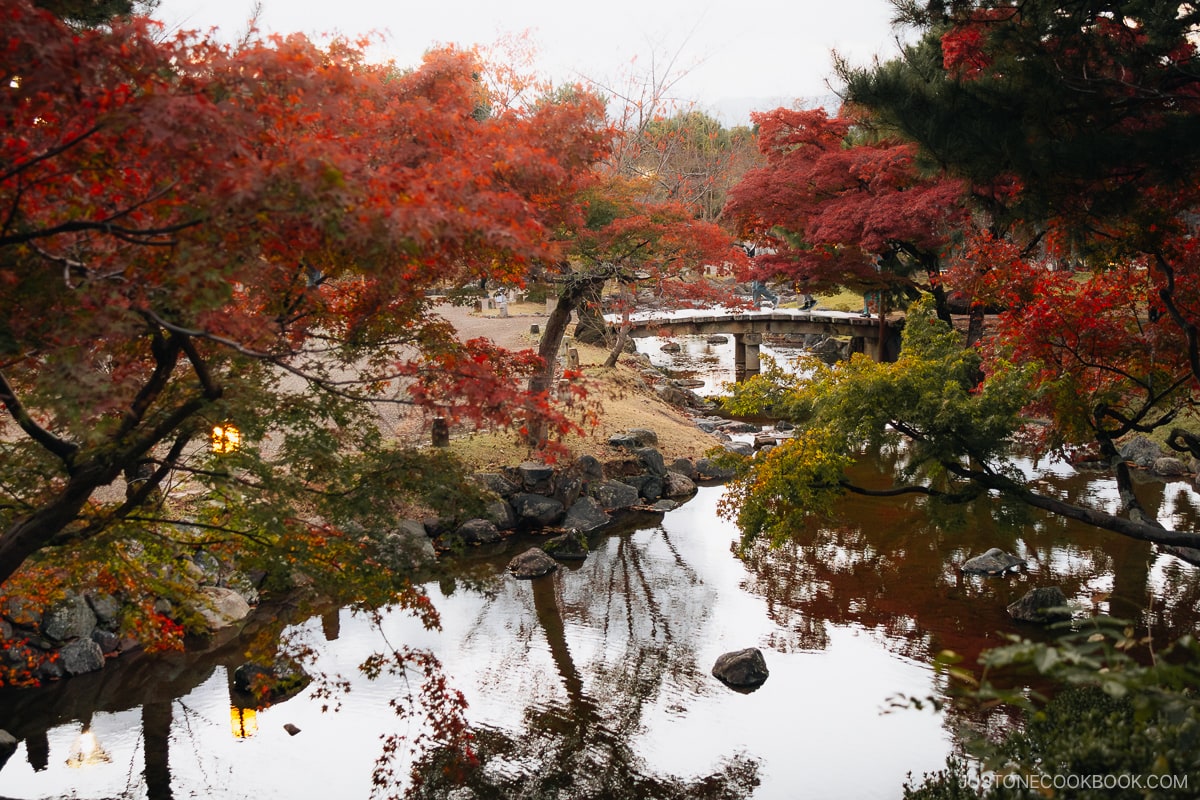

As you enter Nanzen-Ji Temple, the first sight to greet you is the 22-meter-tall Sanmon entrance gate.

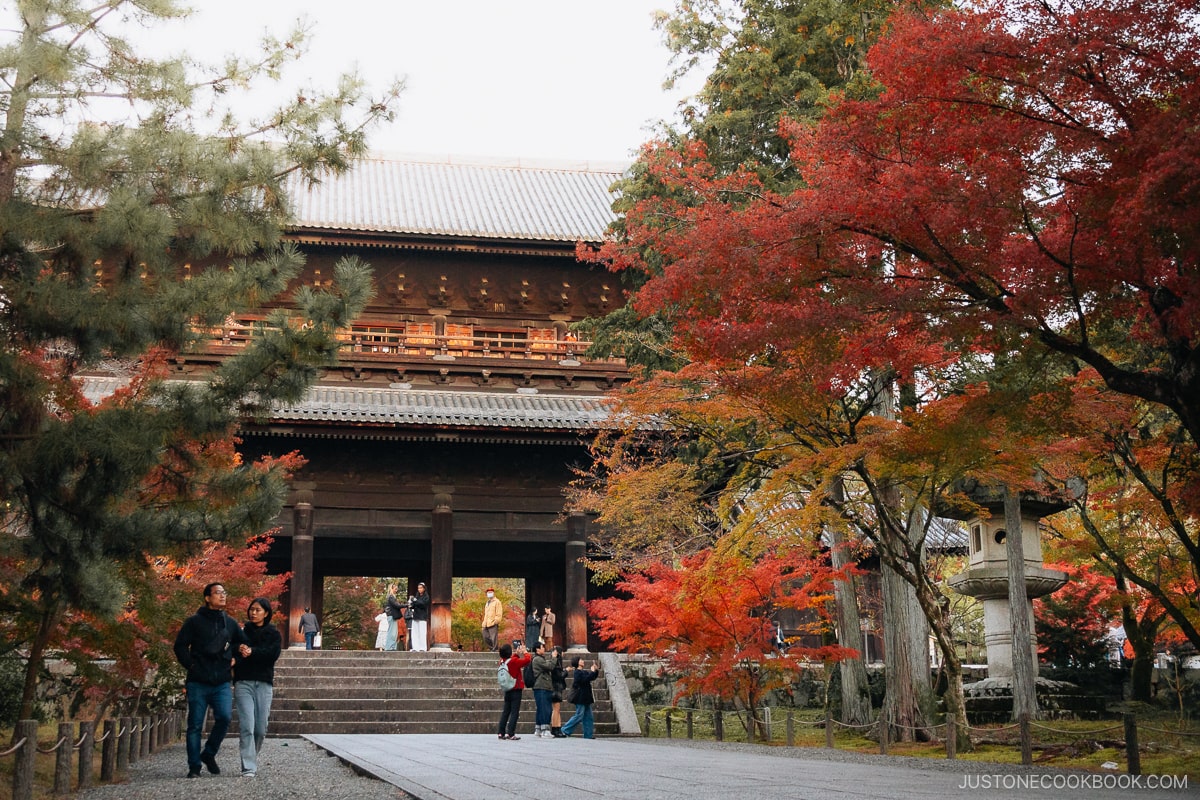
You can enter inside the gate (600 yen admission fee) and climb up to the balcony, granting a view of the temple grounds and Kyoto city. Note that the stairs inside are very steep, and the ceilings are low.
Around the temple grounds, you can enjoy all the colorful autumn leaves and various smaller temples and gardens.




One popular spot is the Suirokaku, a Roman-style Aqueduct. It’s a famous photo-taking spot and has some beautiful foliage, making it even more picturesque.

Inside the Hojo, the former head priest’s residence, and Nanzenji’s main hall, you can enjoy the intricate interior architecture and design, from the stunning fusuma (painted sliding doors) to the outdoor wooden walkways.


The rock garden is the standout feature, with its layout resembling tigers and cubs crossing through water.


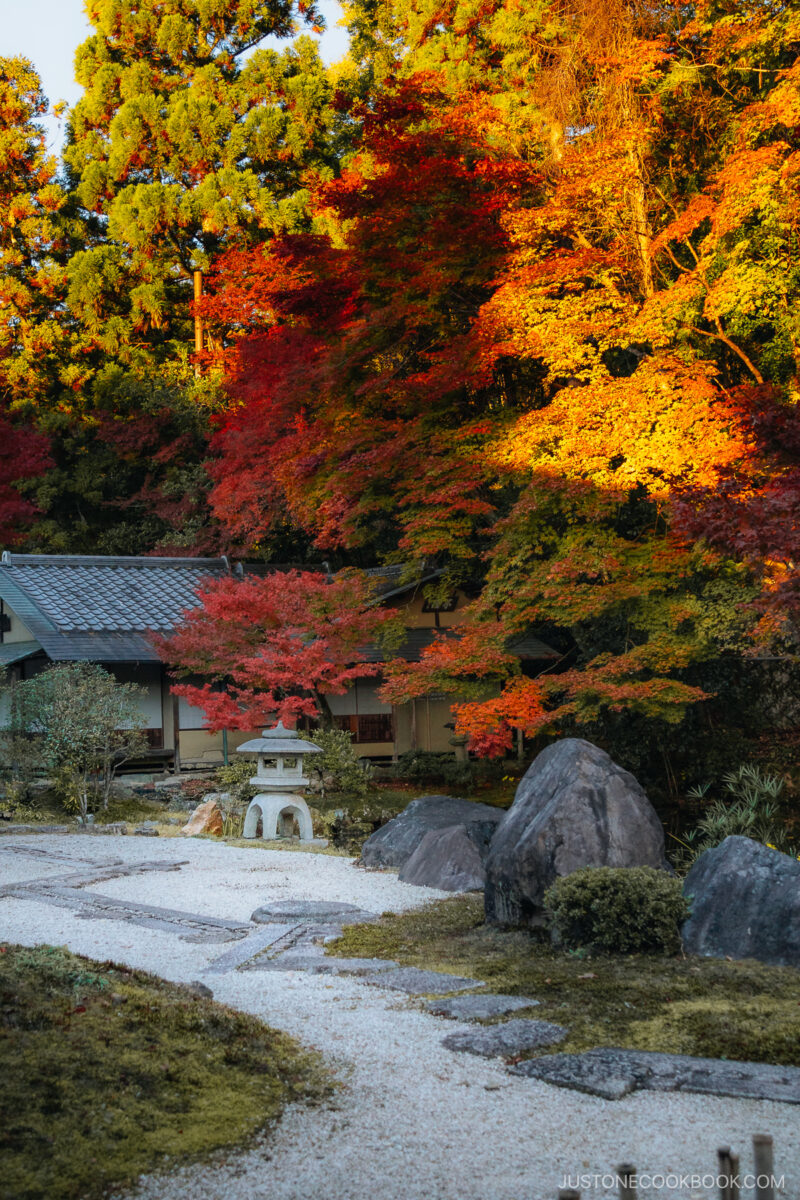
Kodai-ji Temple
Kodai-Ji Temple was established in 1606 in memory of Toyotomi Hideyoshi. For 600 yen, you can enter Kodai-Ji’s Hojo (main hall), where you can roam various buildings and gardens. While the inside was originally covered in lavish lacquer and elegant gold, after several fires, the structure was rebuilt more modestly.
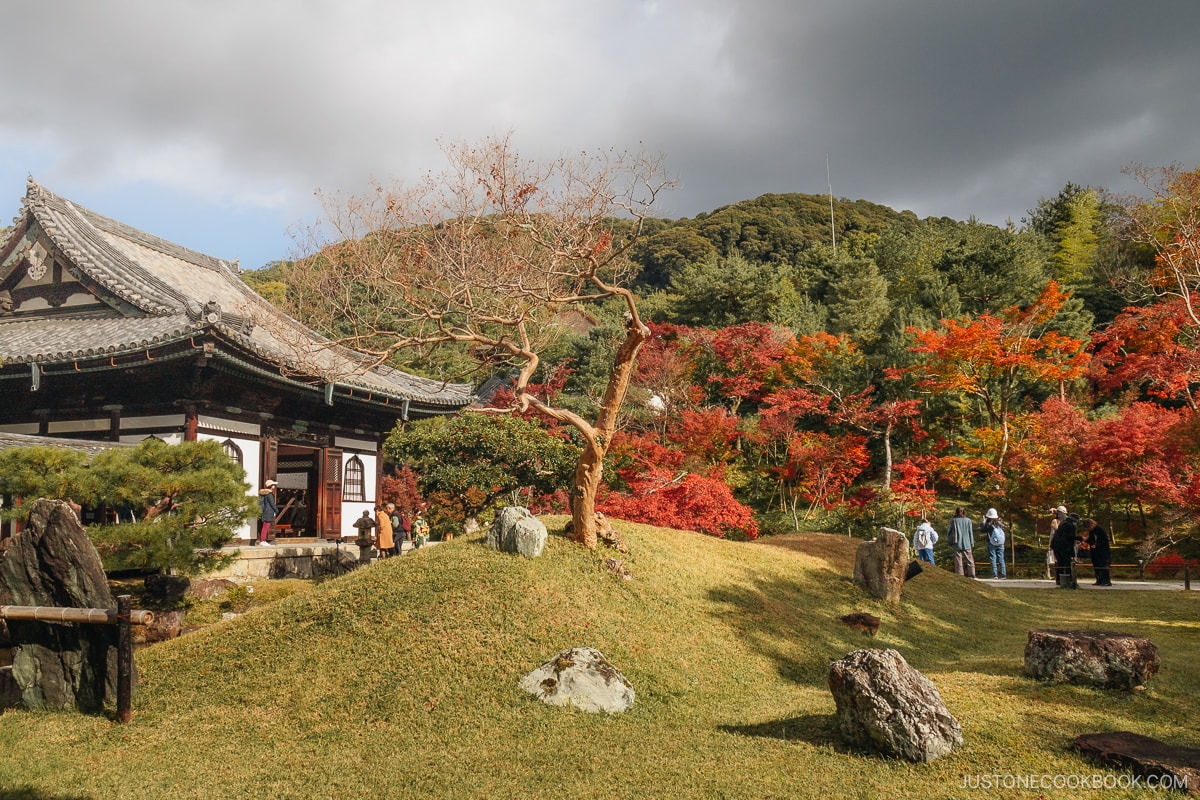
From inside the Hojo, you can admire the vast rock gardens, raked and designed to represent the ocean. During the evening, there is a special illumination and light projection event.

Outside, you can walk around the Tsukiyama-style garden, a classic type of Japanese garden that embodies a miniature of natural scenery.




Made from man-made hills, decorative rocks, mirror-like ponds, and countless maple and pine trees, the garden feels like a tranquil retreat from the crowds in the city.
Not to mention, there is a small bamboo forest like in Arashiyama!

Koknai Komyou-ji Temple
I’ve sung my praises for many different places over in this autumn in Kyoto guide, but the next three areas hold a special place in my heart for this trip.
While most Kyoto itineraries will include famous spots such as Kiyomizu-Dera and Kinkaku-Ji (Golden Pavilion), some of the best spots can often be found just by randomly exploring. While in the Higashiyama area, I had some spare time, so I started to venture into some of the back streets.

Imagine my delight when I stumbled across Koknai Komyou-ji Temple, founded in 1175. At the temple complex’s entrance stood a stately two-story ceremonial gate, built in 1860.

While the temples may not be as impressive as those in other areas, there was an air of tranquility, making it an ideal getaway from the crowds while still savoring Kyoto’s rich history and autumn scenery.
Eishoin Temple
After leaving Koknai Komyou-ji Temple, I chanced across a narrow, unassuming side street leading to Eishoin Temple, built in 1589 by Morikatsu Kimata.

Walking down the narrow path and through the small gate, the breathtaking garden revealed itself.
A Buddha statue overlooking the garden was nestled away in the autumn leaves.

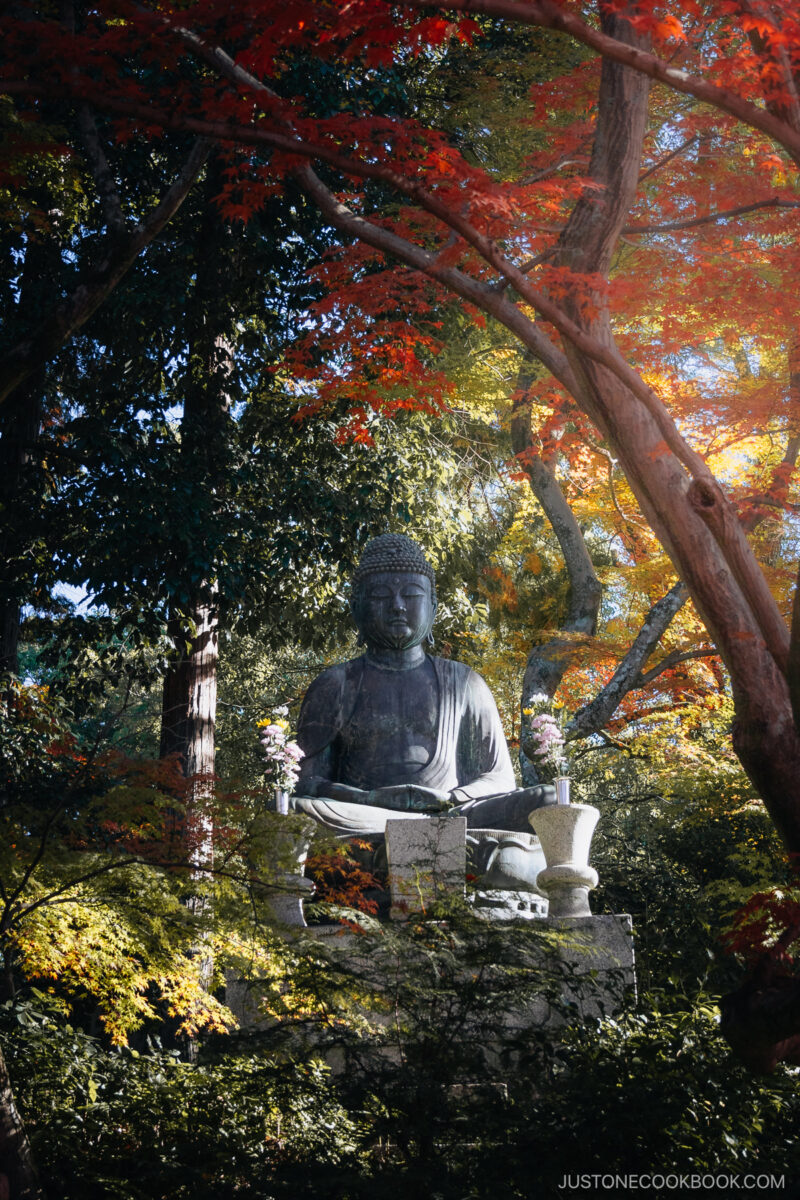

There is a wooden terrace-style bench that is free to sit on. When I arrived, there was only one person there reading their book.
Along with the sound of singing birds and the serene atmosphere, it felt like this was Kyoto.

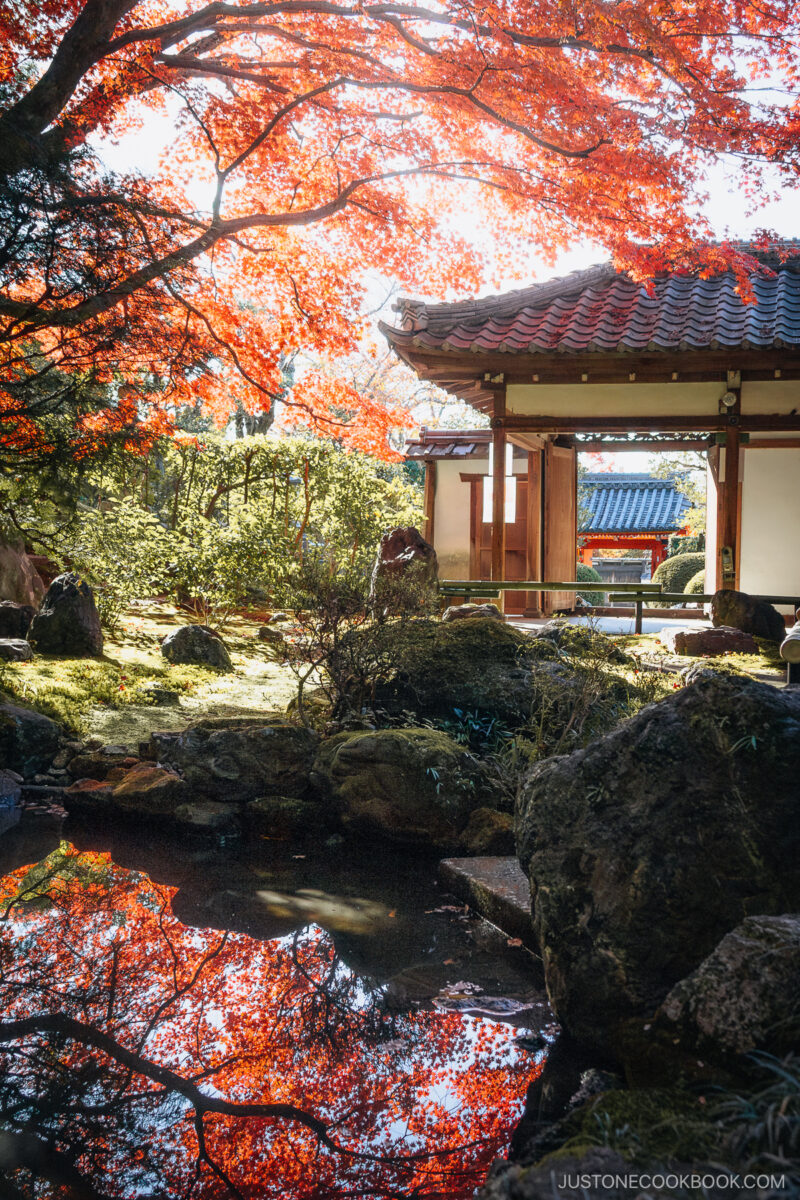
Please note that the garden is only open during autumn.
Shinsou Gokuraku-Ji Temple
Just a little further up was Shinsou Gokuraku-Ji Temple, built in 984 by the monk Kaisan.

The temple grounds are carpeted in reds, oranges, and yellows, and a beautiful three-story pagoda gracefully rises above the maple trees.



There are benches and places to stop, rest, and admire the scenery.


Walking through, it felt like I was part of the people of Kyoto’s daily life. People walked their dogs, enjoyed picnics, and sat on the benches, watching time pass.
Eikando Temple
Many temples, shrines, and parks have special light-up illuminations from late October to early December. Some last for the whole period, while some are only open for a week.

As I was in the Highashiyama area, I visited the Eikando illuminations. Even though I arrived 30 minutes before opening, there was already a queue of around 200 people, which slowly grew longer and longer.
Inside the grounds, while you can enjoy the magical night scenery, there were no spots to relax because of the crowds.

The most impressive spot was the Hojo Pond, where you can enjoy the reflections of the autumn leaves in the pond.


There is also a small area selling sweets and drinks and seating to rest.

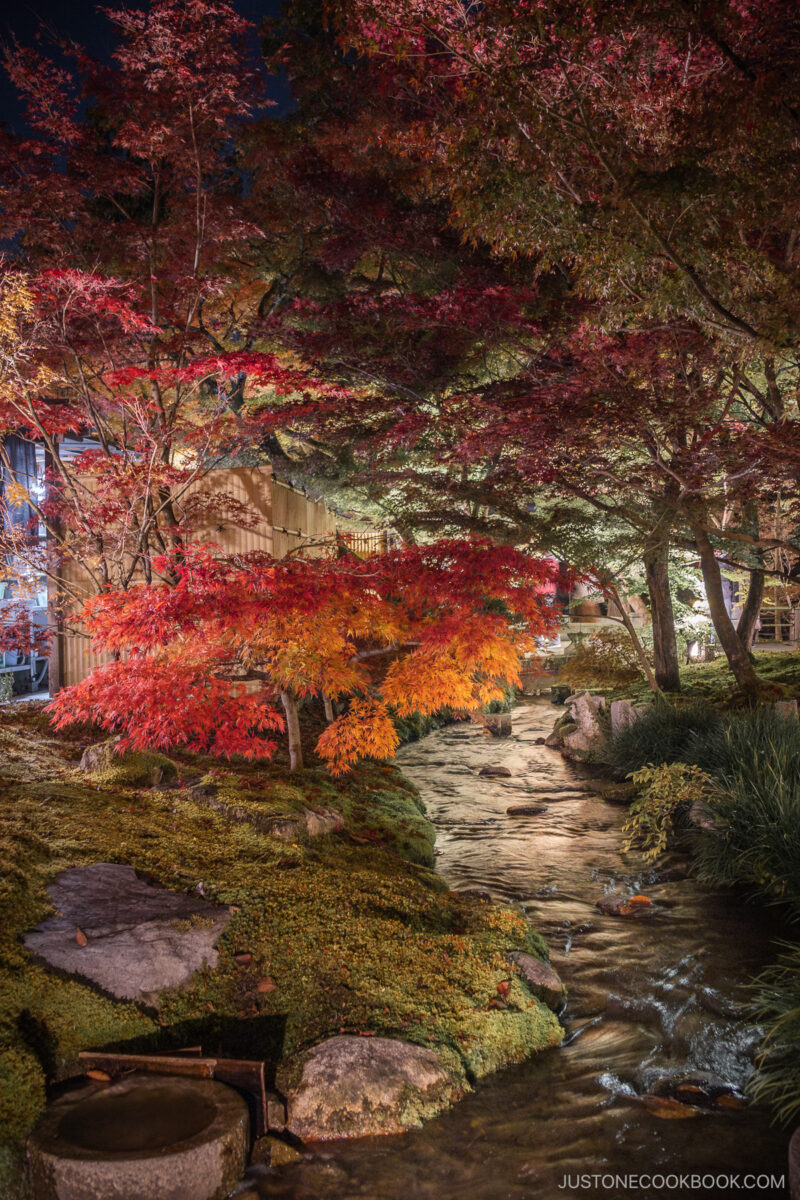

The crowds of people can be overwhelming, and at times, I felt as if I was being rushed through. However, Eikando is worth the visit, especially the Hojo Pond.

Arashiyama
The surrounding mountains of Arashiyama, lining the Katsura River, offer some of the most splendid autumn scenery in the city. From the banks of the river and Tsutenkyo Bridge, you can gaze upon the burning crimson reds and hues of orange and yellow that cascade down the mountain sides and glisten in the water.

You can even get up close to the maple trees by taking a river cruise or renting a rowing boat and enjoying the scenery from the water. Along with the warmth of the sun, cool autumn breeze, and the sound of flowing water, Arashiyama is a must-visit.
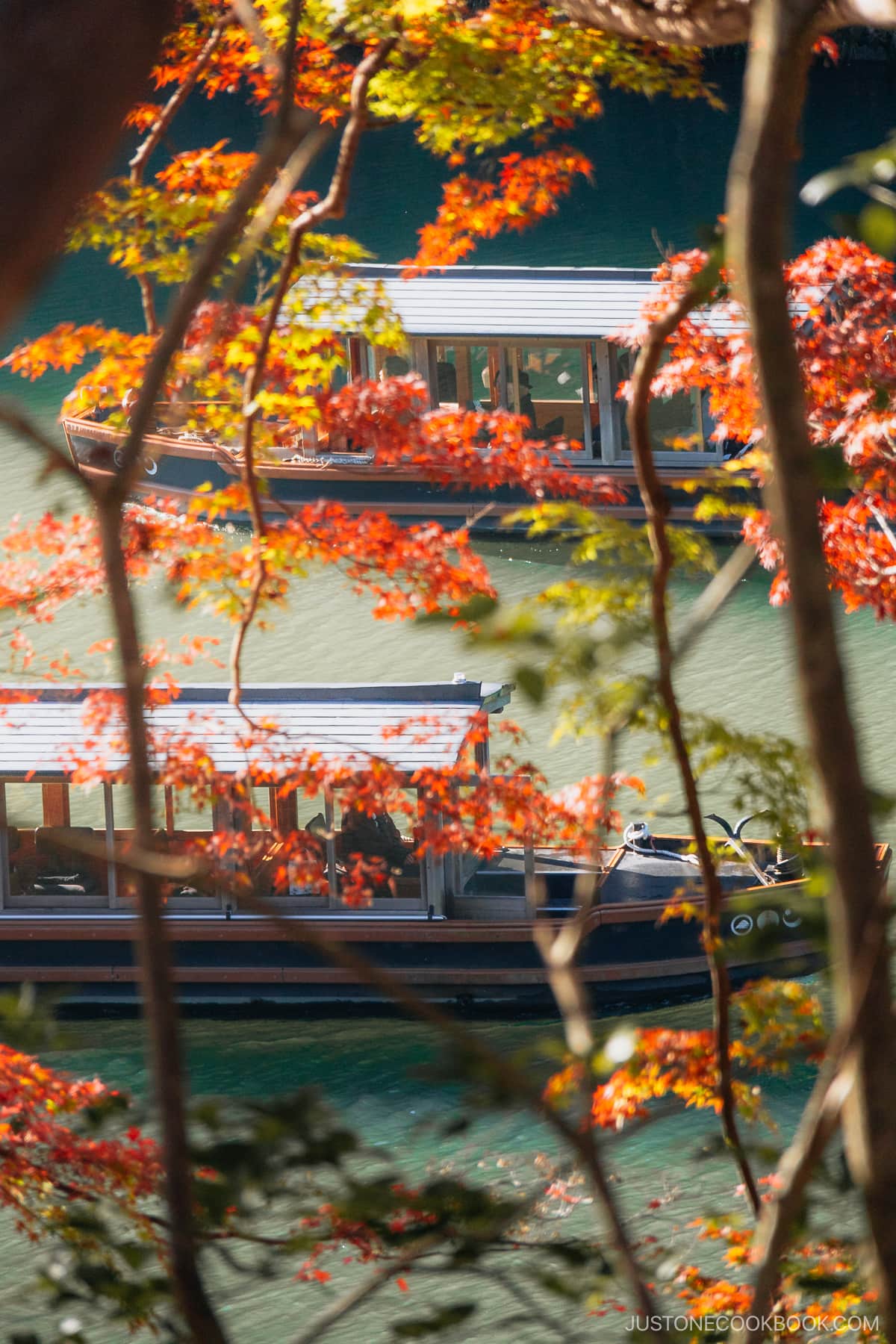
While the area is renowned for its bamboo forest, it doesn’t undergo much change during the autumn season. There are several shrines and temples surrounding the area where you can escape the crowds and relax amidst the fall colors. There is much more to explore beyond the bamboo forest, which I will cover in a dedicated Arashiyama post coming soon.


Ninna-Ji
Ninna-Ji’s history dates back to 888, and it is one of Kyoto’s great temples listed as a World Heritage Site. It serves as the head temple of the Omuro School of the Shingon sect of Buddhism. Many temples across Japan belong to the Omuro School, with numerous priests visiting Ninna-Ji for study and training.


Due to the many wars and fires throughout Kyoto’s rich history, all the original buildings have been destroyed. The longest-standing structures date back to the early 1600s in the Edo Period.

The main attraction of Ninna-Ji is the Goten, the former residence of the head priest. The Goten is connected by a sequence of covered corridors.

Throughout the Goten, you can find beautiful fusuma (painted sliding doors), historical artifacts, and traditional architecture while enjoying the surrounding gardens.
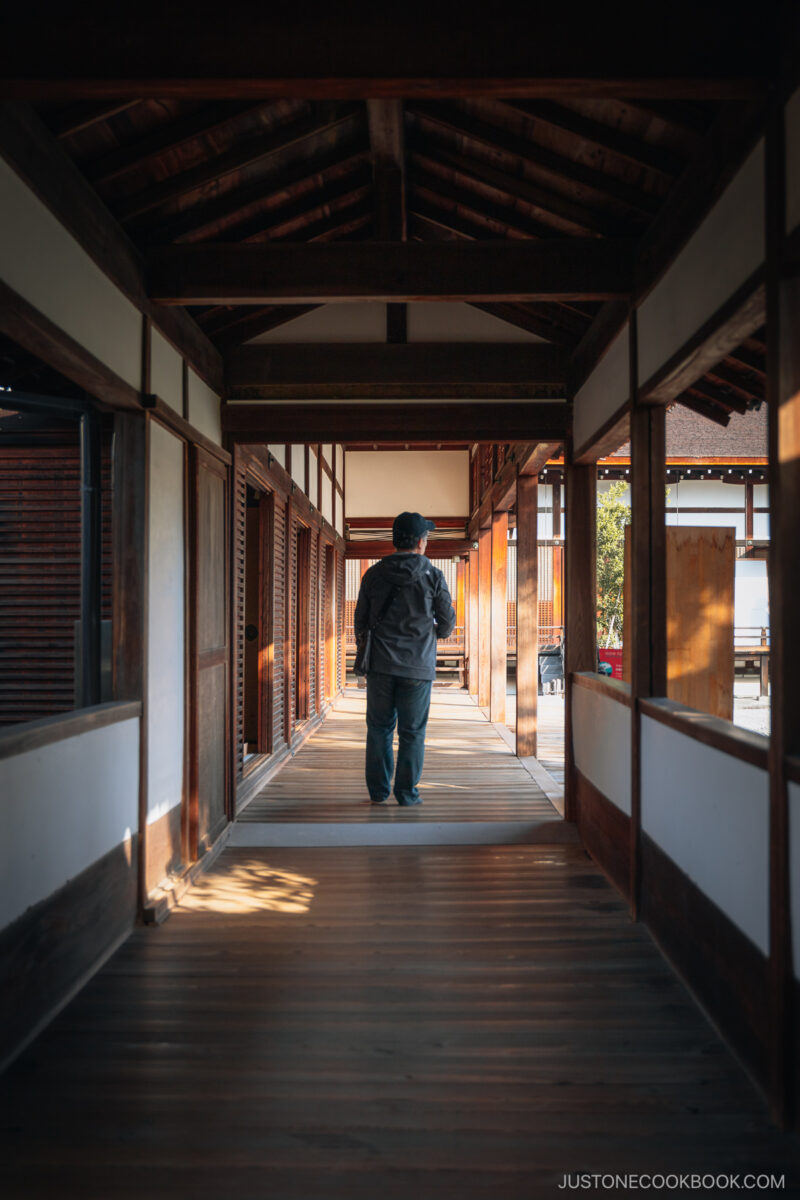
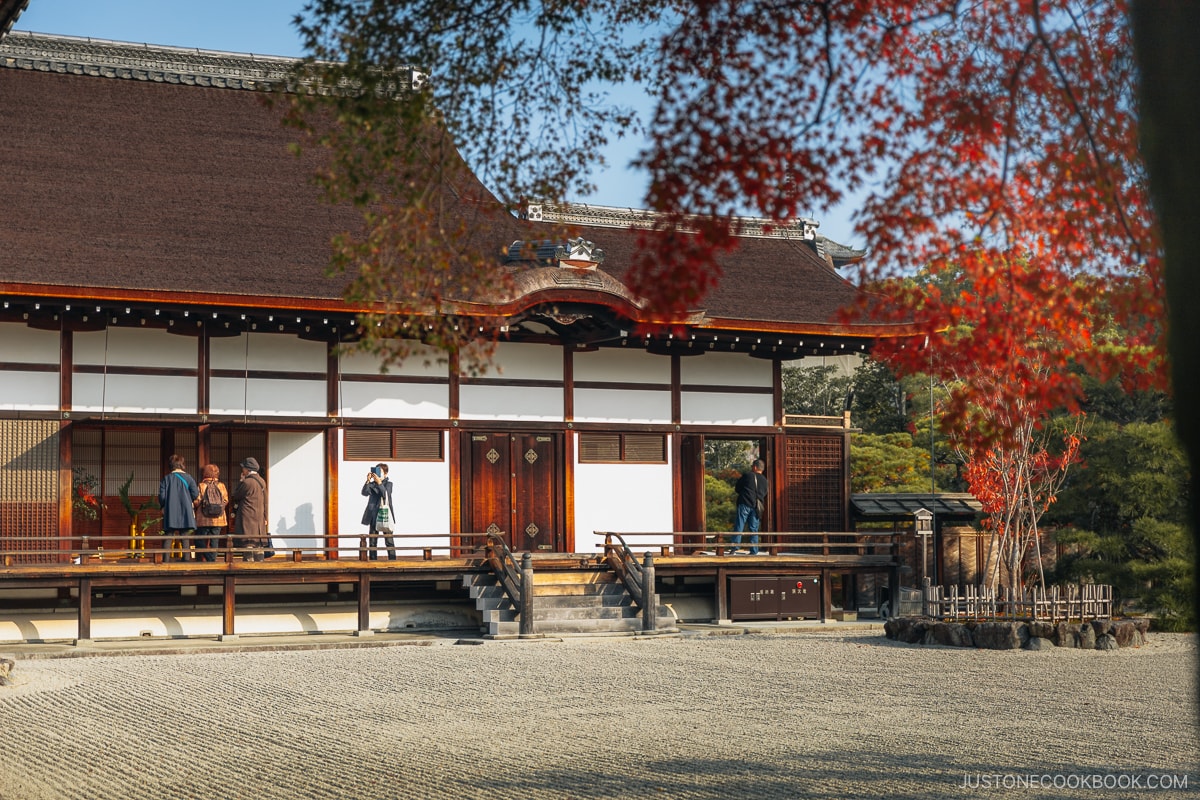


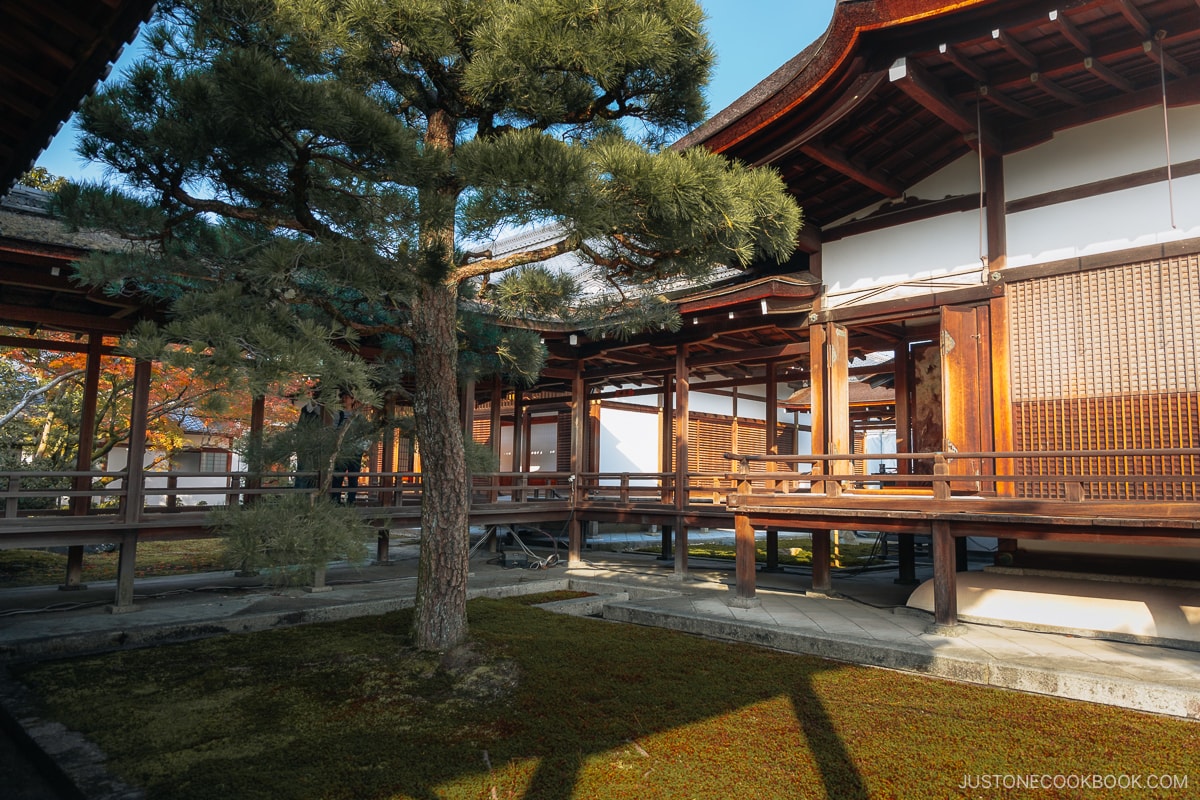



Although Ninna-Ji is most famous for its cherry blossom season, I found that the autumnal colors enhanced the beauty and elegance of the temple’s architecture, and there were very few people there!



Scattered around the grounds are various shrines, a five-story pagoda, and a museum.
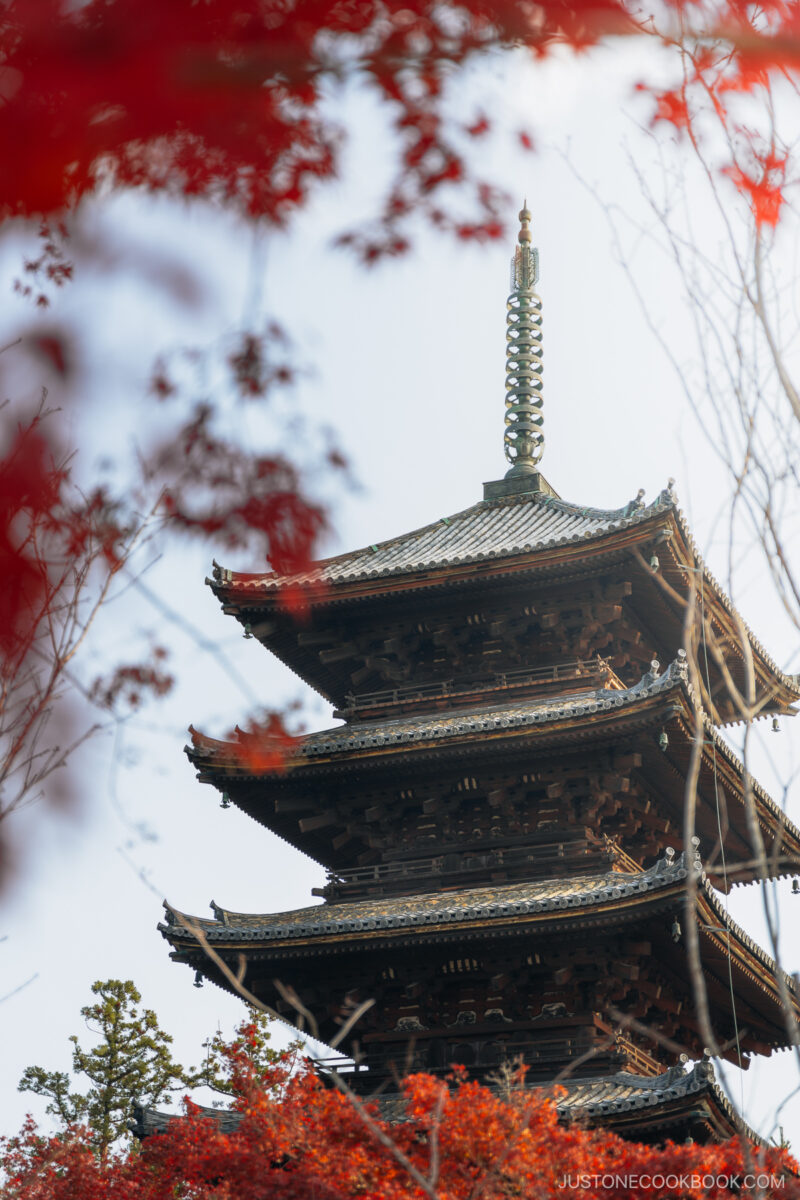

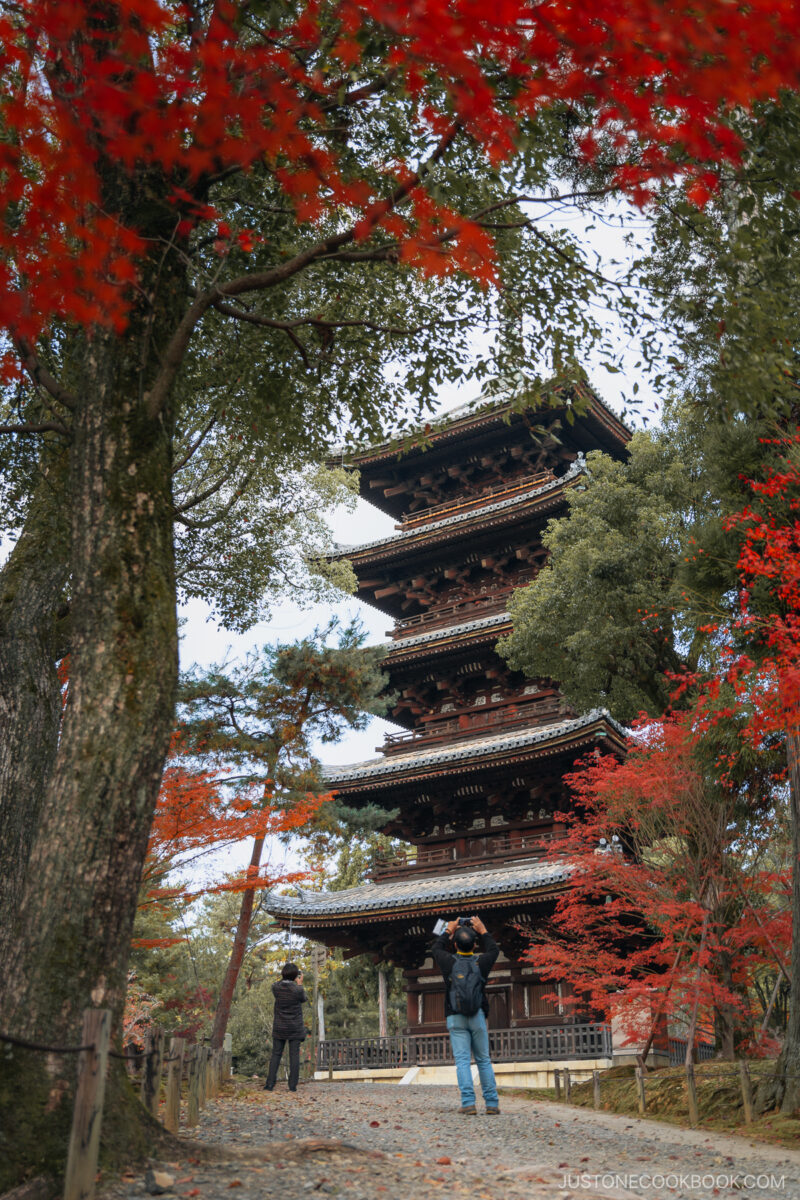

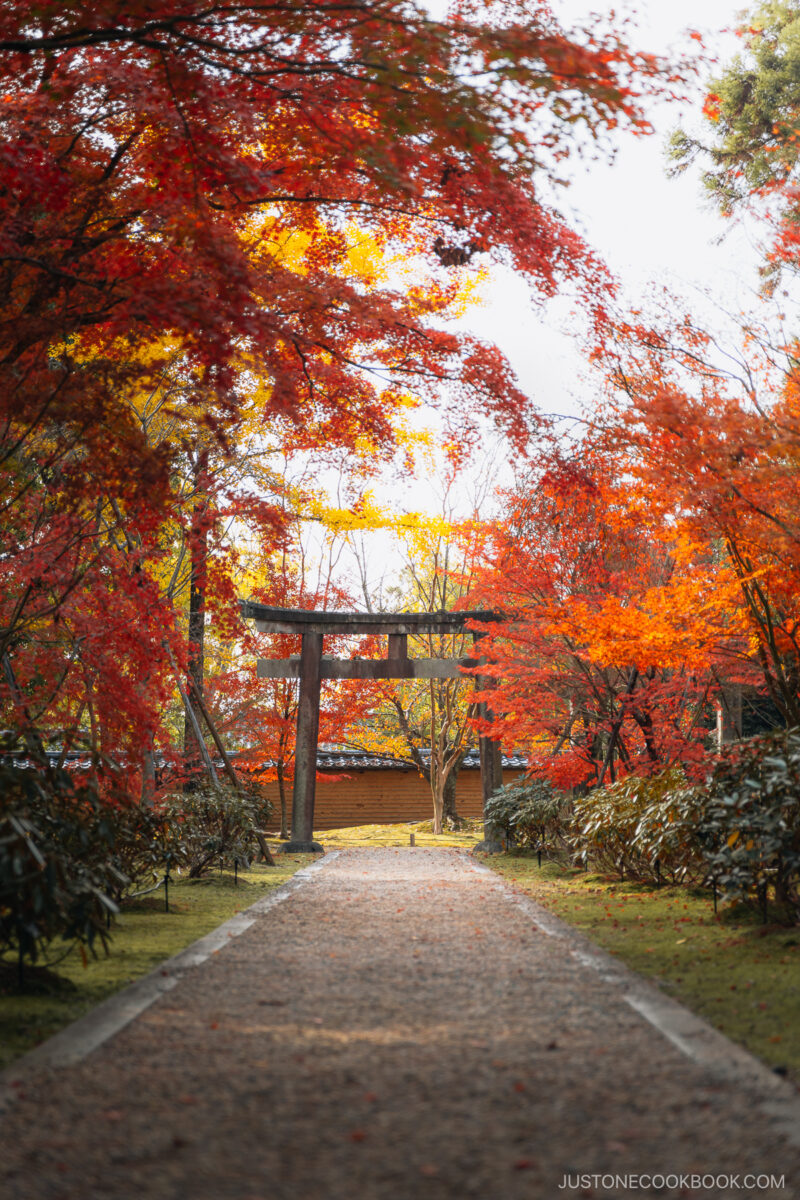

You can also relax and enjoy some drinks and food at the cafe.
You’ll also be able to find some Yae-zakura (double cherry blossom), which bloom once in spring and again in autumn!


For adults, there is an 800 yen entrance fee for the Ninna-Ji grounds and Goten, with an extra 500 yen to enter the Reiho-Kan Museum. Admission is free for children.
Ryoan-Ji
Ryoan-Ji houses one of Japan’s most famous rock gardens and was established by Hosokawa Katsumoto, the deputy to the Ashikaga shoguns in 1450. It is listed as a UNESCO World Heritage Site. Originally a villa, Kasumoto invited the Zen Priest Giten Gensho to help transform it into a temple.

When you enter Ryoan-Ji through the San-Mon (main gate), you’ll see the pathway shrouded in maple trees.
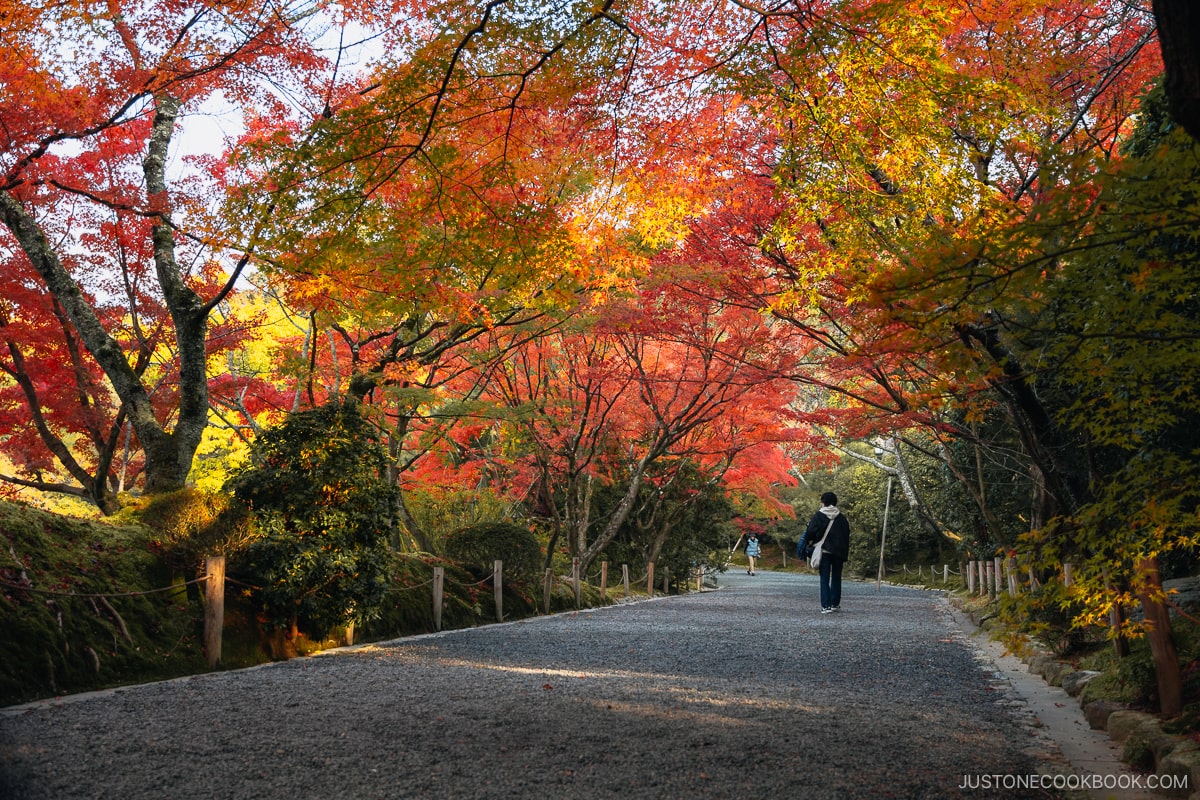
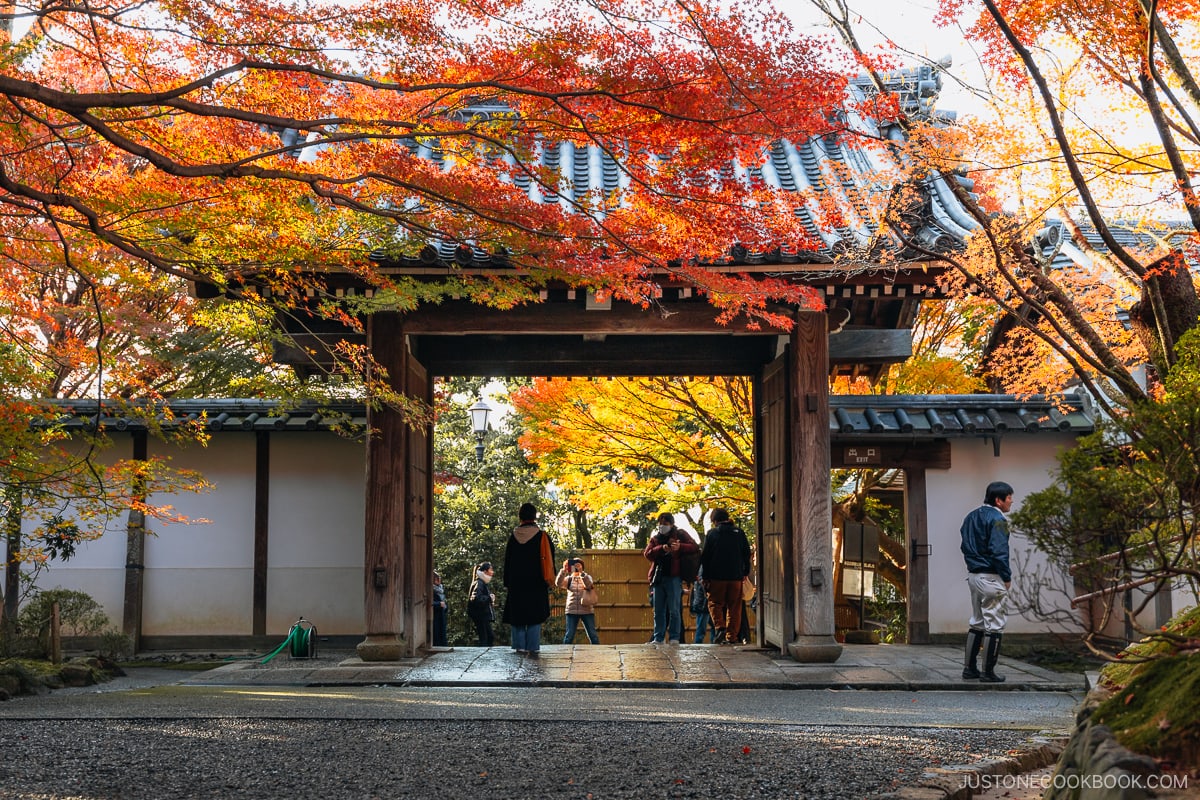
To the left, you’ll have a view of Kyoyochi Pond, featuring a small shrine on one of its three little islands that can be accessed over a bridge.


Following the pathway, you’ll reach the Hojo, the head priest’s former residence with the famous rock garden.
Inside the Hojo, you can marvel at the fabulous fusuma and tatami rooms.




The meaning of the garden is unclear, with some saying that it represents a series of mountain heads appearing through a sea of clouds. Others say it is a tiger carrying cubs across a pond, while some say it represents infinity. It certainly opens up to our imaginative interpretation.



You can sit along the wooden walkway, soaking in its tranquility, and watch the leaves cascade down from the overhanging trees.
Around the temple grounds, you can enjoy the surrounding nature and various buildings.



There is also a restaurant specializing in Yudofu (boiled tofu), a Kyoto specialty, but it was closed as it was early in the morning.




There is a 600 yen admission fee for adults.
Enkouji
Before my trip, I asked a friend living in Kyoto for recommendations, and she couldn’t sing enough praise for Enkouji.
Founded in 1601 by Shogun Ieyasu Tokugawa, Enkouji was built as an educational institution. The temple published numerous books such as “The School Sayings of Confucius” and “Essentials of the Zhenguan Period Government,” with the original wooden printing blocks stored inside the temple.


Once you walk past the gate, you’ll come across Honryutei, a rock and sand zen garden. The swirl and flow of the sand represent a sea of clouds, with the arranged stones symbolizing a dragon flying freely in the sky.

The path leads to Jyu-gyu no niwa, a circular garden that represents the path to enlightenment.



You can enter the surrounding buildings and get picture-frame views of the garden.You’ll also find a patch of bamboo trees similar to the Arashiyama bamboo forest.
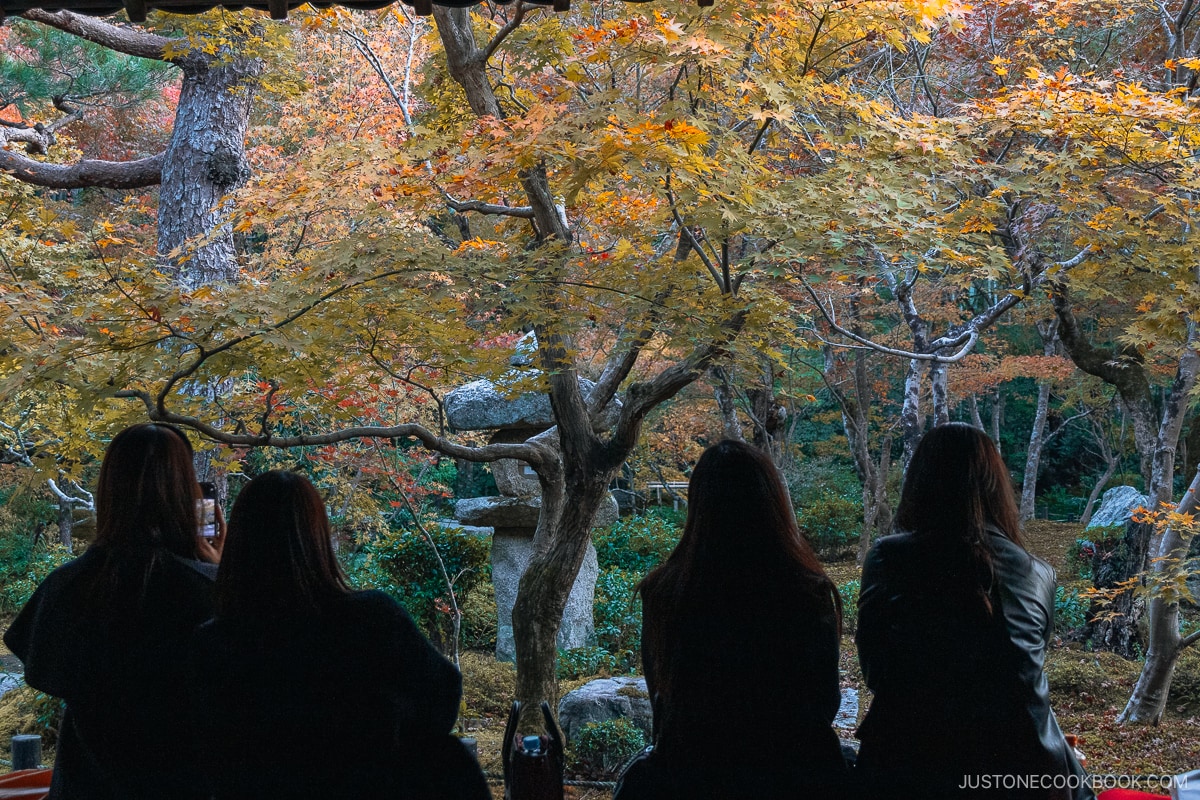


Climbing up the stairs, you can enjoy panoramic views over the city, beautiful autumn leaves, and Enkouji.

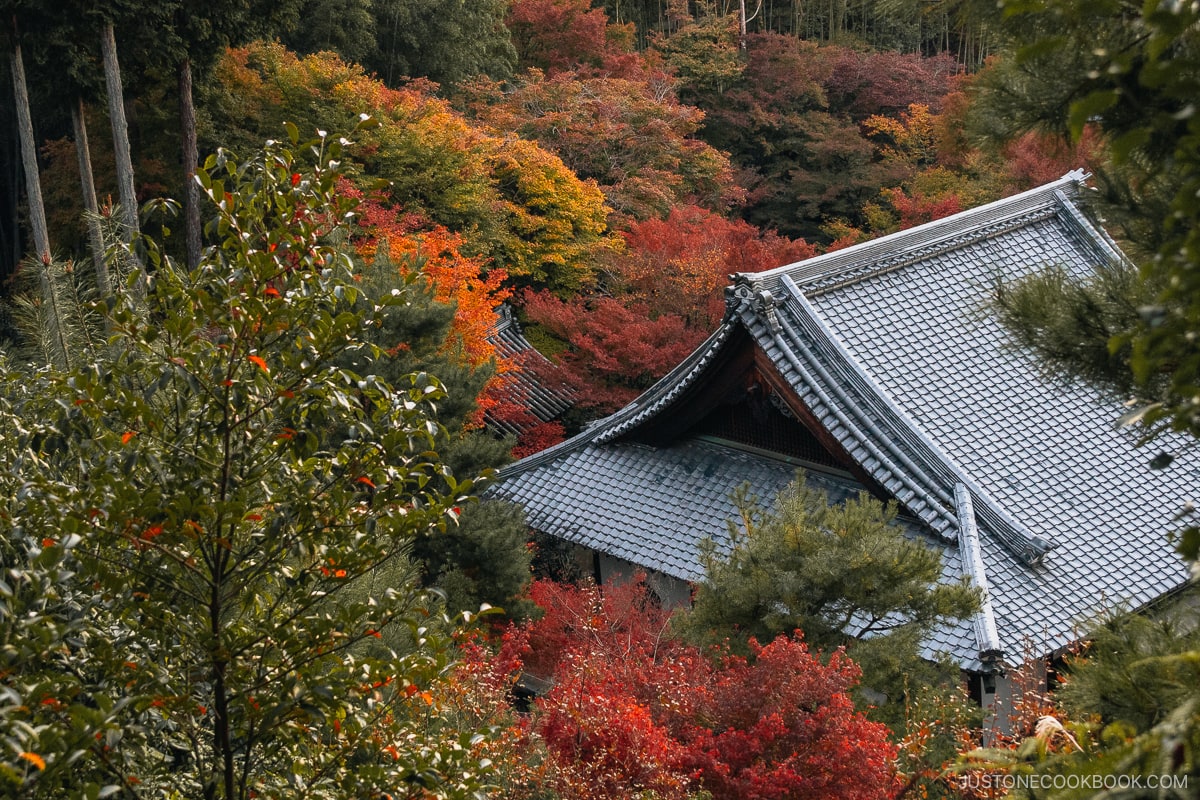


In 2023, visitors had to reserve a ticket online (1,000 yen for adults and 500 yen for children) to enter Enkouji during autumn. It is possible to enter through tickets at the door, but it depends on the current capacity. You can find more details on their website.
Sanzen-in
Located approximately an hour away from central Kyoto, Sanzen-in Temple is situated in the small rural town of Ohara. It was originally established as a hermitage by Saicho (767-822), who introduced Tendai Buddhism to Japan in 804. The temple complex features various gardens, walking trails, and buildings to explore, with a 700 yen admission fee.

The winding path leading up to Sanzen-in is lined with shops and restaurants.


The first major building on the grounds is the Kyakuden (guest hall), which exhibits calligraphy works and fusuma.
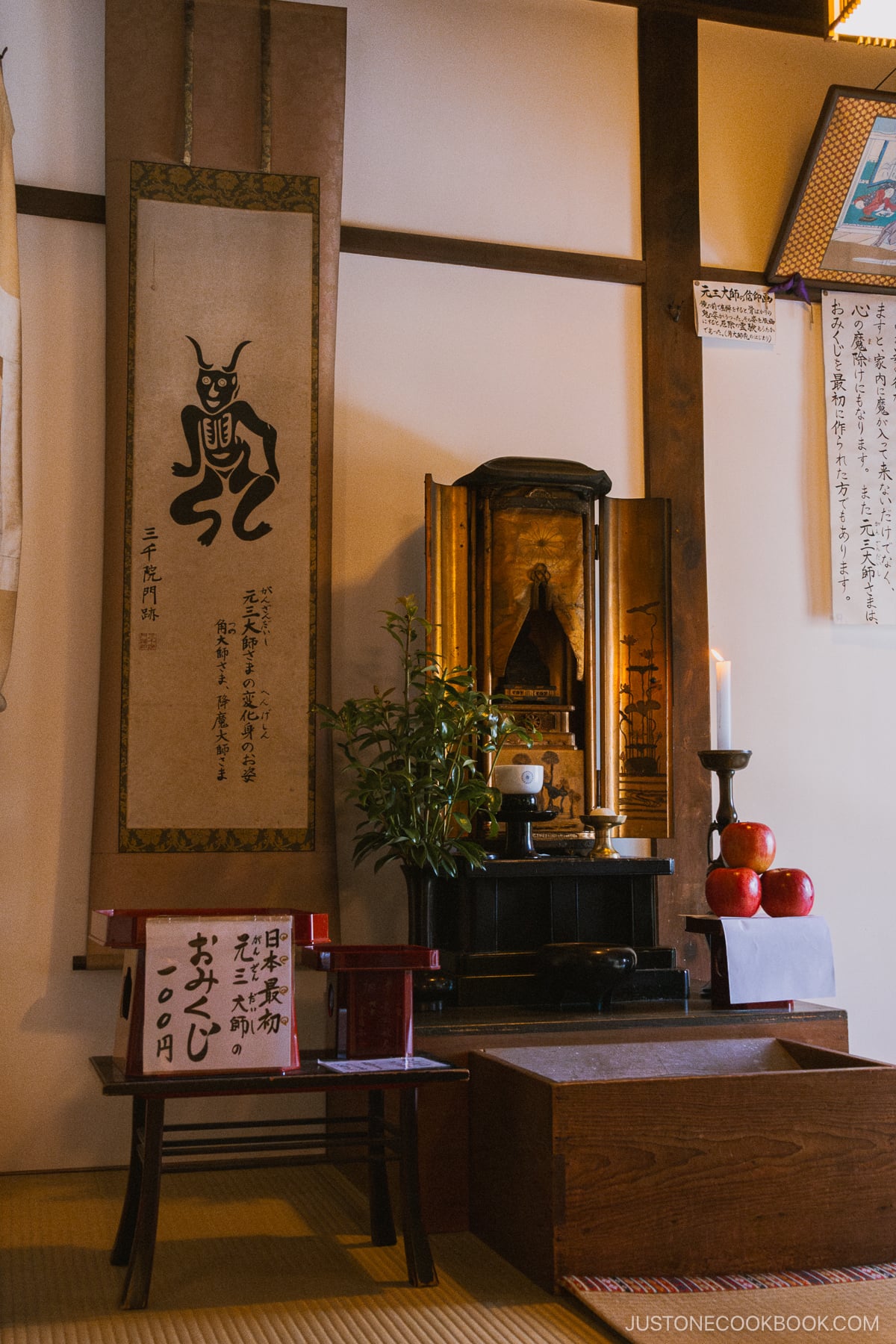
It then opens up to Shuhekien Garden, where you can enjoy some matcha and wagashi (traditional Japanese sweets) on the hall terrace.




Connecting next to the Kyakuden is the Shinden (main hall), which exhibits three Buddhist deities: Amida Buddha, Kannon, and Fudo Myoo.
The Shinden leads down into the moss garden, where you can see Ojo Gokuraku-in Hall, the oldest temple building in Sanzen-in.




From here, you can walk around the various gardens and trails, enjoying the autumn foliage.

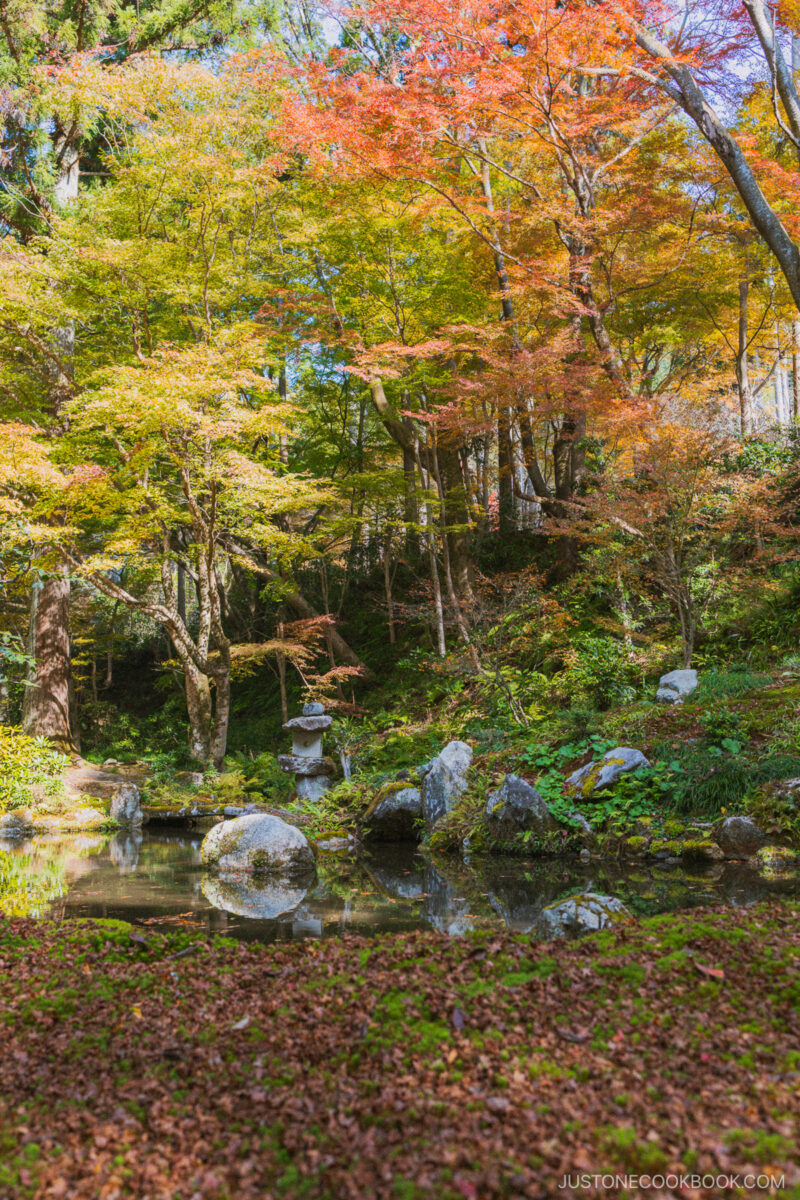
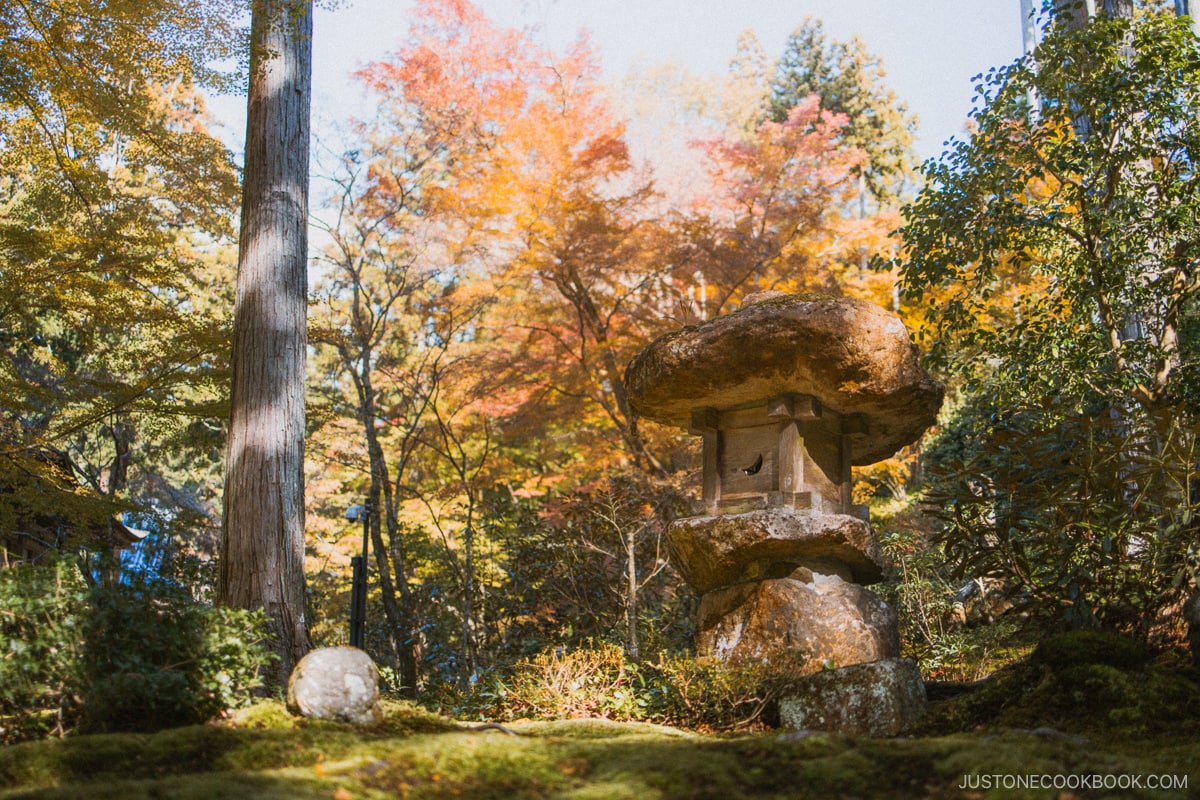


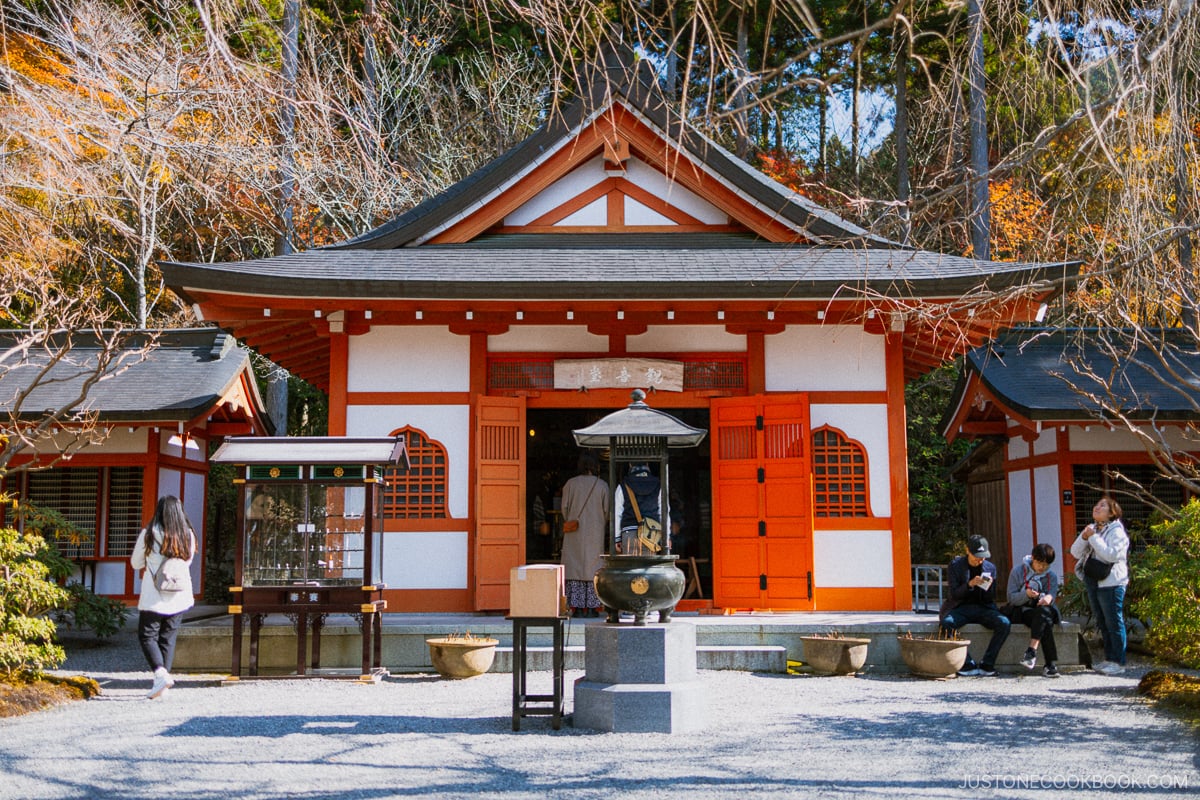


After you’ve finished exploring, you can stop by one of the many restaurants and shops. Pick up some souvenirs or indulge in some Nishin Soba (mackerel buckwheat noodles), a Kyoto specialty.

As Sanzen-in is situated a little further north, the leaves change color a bit earlier than in central Kyoto. Unfortunately, I think I visited a bit too early! Nevertheless, Sanzen-in was one of the most beautiful temple complexes I explored during my time in Kyoto. The easiest way to reach Sanzen-in is by taking the number 17 bus from Kyoto Station to Ohara, which takes a little over an hour. From the Ohara bus stop, it’s a 12-minute walk.
Kifune Shrine
To get to Kifune Shrine, board the Eizan Kurama Line from Demachi-Yanagi Station to Kibune-guchi Station, taking around 30 minutes. From the station, it’s a 25-minute scenic walk to Kifune Shrine.


The Eizan train also passes through a tunnel of 280 Japanese maple trees between Ichihara Station and Ninose Station. When riding the train, you can enjoy the scenic views during the day or evening when it is magically illuminated. However, it is VERY popular, and despite what some social media posts may suggest, the train is extremely busy during the autumn season.

Kifune Shrine is dedicated to the god of water and rain and is believed to be the protector of those at sea. Legend has it that a goddess traveled from Osaka along the river, and her journey concluded in northern Kyoto, where Kifune Shrine was subsequently built.
Leading up to the shrine, you’ll find several ryokans (traditional Japanese inns), restaurants, and cafes. During the summer months, restaurants offer outdoor seating by the river, allowing visitors to enjoy a meal as the water flows beneath them.



Along the trail, you can stop for a snack or enjoy some traditional Japanese sweets, such as Matcha Zenzai.


A set of stairs lined by lanterns and maple trees mark the entrance to the main shrine, Yui no Yashiro. Here, you can make your wishes and prayers, and also enjoy the surrounding scenery from the observation deck.




If you hike another kilometer up, you’ll reach the original grounds of the shrine, Okunomiya. During my visit, there was a small market selling local foods and goods.



Despite being just a short train ride away, Kifune Shrine feels like a world away from the bustling center of Kyoto. There is something tranquil and calming about both the walk and the shrine itself. If you’re looking to get away from the city, then Kifune Shrine is a must-visit for you.

Enjoy Autumn in Kyoto – Koyo
Autumn in Kyoto is truly special, and I hope you’ll have the opportunity to experience it yourself. In my next post, I’ll share tips on enjoying one of the city’s most popular areas, Arashiyama, and highlight the top places you must visit.
If you have any questions about visiting Kyoto, leave them in the comments below.











Beautiful pictures, Andy! Especially the ones where the autumn leaves are reflected in the water. Thanks for providing alternative bamboo groves and rock gardens; it may just be the solution to avoid the crowds. And I agree with Diane, the rakan statues were delightful!
I love your guide but next time you go to Kyoto, please got o Otagi Nenbutsu Temple. It’s my favorite! So unique – I could spend hours there looking at the different sculptures.
Hi Diane!
Thank you for the recommendation! I’ll definitely check it out when I’m next in Kyoto!
Thanks,
Andy